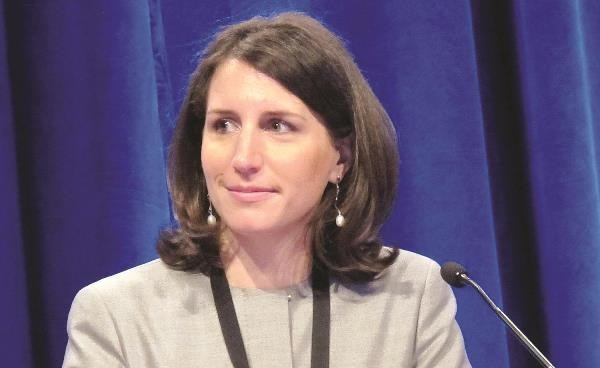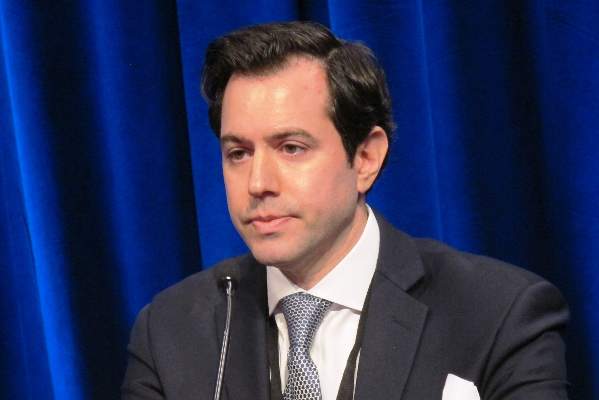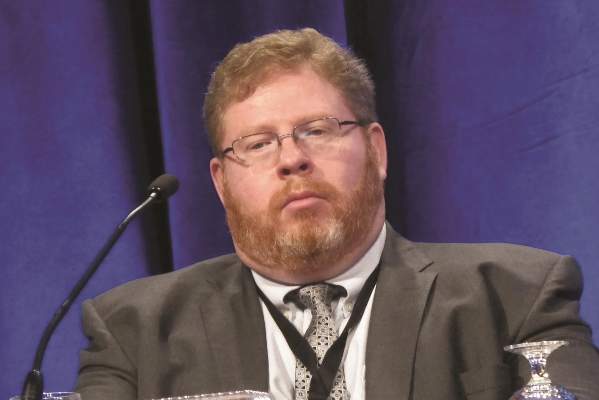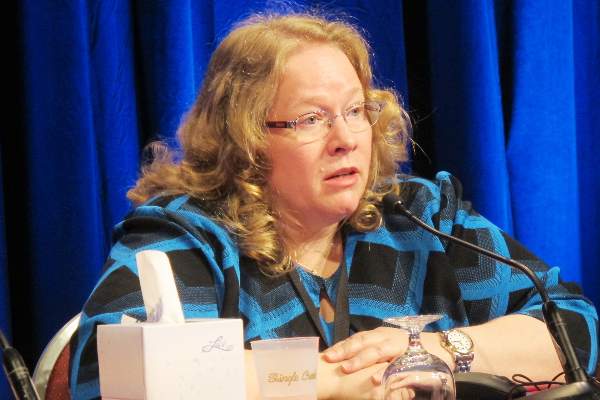User login
American Society of Clinical Oncology (ASCO): Genitourinary Cancers Symposium
Higher BMI linked to better metastatic RCC outcomes
ORLANDO – Talk about a paradox: high body mass index is a known risk factor for renal cell carcinoma, but previous studies have shown that patients with high BMI who develop localized RCC generally present with lower grade disease and have better outcomes than normal-weight patients.
Now, investigators confirm that overweight or obese patients with metastatic renal cell carcinoma (mRCC) also tend to have a better prognosis than their leaner counterparts when treated with targeted therapies.
“We externally validate that BMI impacts the outcome of patients with metastatic kidney cancer treated with targeted therapy in terms of overall survival (OS), progression-free survival, and overall response rates,” said Dr. Laurence Albiges, a visiting scientist in the Kidney Cancer Center at the Dana-Farber/Brigham and Women’s Cancer Center, Boston.
Although the mechanism for a protective effect of excess weight is not clear, there is some evidence to suggest that fatty acid metabolism in mRCC may play a role, she said at the 2015 Genitourinary Cancers Symposium sponsored by the American Society of Clinical Oncology.
In tissues samples from The Cancer Genome Atlas (TCGA, a joint repository of the National Cancer Institute and National Human Genome Research Institute), expression of FASN, a gene that encodes for fatty acid synthase, was associated with overall survival (OS), but in other samples FASN expression was not an independent prognostic factor for OS, she said.
Investigate and verify
To clarify the role of BMI in mRCC, Dr. Albiges and colleagues looked at data from clinical trials, specimens from the International Metastatic Renal Cell Carcinoma Database Consortium (IMDC), and biologic data from the TCGA.
As the group reported at the 2014 ASCO annual meeting (Abstract 4576), they first looked at the effect of low BMI (< 25 kg/m2) vs. high BMI (≥ 25) in 1,975 patients with mRCC in clinical trials, and found that after adjustment for IMDC prognosis groups, higher BMI was associated with better OS (median 25.6 months vs. 17.1 months; hazard ratio, 0.84; P = .0079) and longer time to treatment failure (median 8.1 vs. 5.7 months; HR, 0.86; P = .0067).
They then, in collaboration with Pfizer Oncology, conducted an external validation study using data on 4,657 patients with mRCC treated in phase II-III clinical trials from 2003 through 2013.
After adjustment for various risk factors, they found again that BMI of 25 or greater was associated with better outcomes in terms of overall survival (23.4 vs. 14.5 months; HR, 0.830; P = .0008), progression free survival (8.2 vs. 5.5 months; HR, 0.821; P < .0001), and overall response rate (25.3% vs. 17.6; adjusted odds ratio, 1.527; P < .0001).
Dr. Albiges noted that when patients were stratified by histologic subtype, “the favorable outcome associated with high BMI was only observed in clear cell RCC.”
The investigators next looked at information from the TCGA dataset on patients with metastatic clear cell RCC to see whether there was correlation between BMI and survival and between BMI and FASN expression. Although they did not detect a significant survival advantage for higher BMI in this cohort, they did find that higher BMI was significantly associated with lower FASN expression levels (P = .034), and that FASN expression below the median level was associated with better overall survival (P = .002).
Finally, they examined biospecimens from the IMDC dataset with information about outcomes under targeted therapy. Here, they found that FASN staining was associated with prognosis groups, but was not an independent prognostic factor for OS in multivariable analysis.
“BMI, however, is associated with overall survival independently of FASN,” Dr. Albiges said.
Although the mechanisms for the effect of BMI on survival are not clear, the study supports observations that many oncologists have made in clinic, said Dr. Ulka Vaishampayan, chair of genitourinary oncology at the Karmanos Cancer Institute at Wayne State University in Detroit.
“There is obviously, I think, a clinical gestalt that we all have, that people who are not losing a lot of weight are in general doing better across a number of malignancies,” she said. Dr. Vaishampayan was the invited discussant.
ORLANDO – Talk about a paradox: high body mass index is a known risk factor for renal cell carcinoma, but previous studies have shown that patients with high BMI who develop localized RCC generally present with lower grade disease and have better outcomes than normal-weight patients.
Now, investigators confirm that overweight or obese patients with metastatic renal cell carcinoma (mRCC) also tend to have a better prognosis than their leaner counterparts when treated with targeted therapies.
“We externally validate that BMI impacts the outcome of patients with metastatic kidney cancer treated with targeted therapy in terms of overall survival (OS), progression-free survival, and overall response rates,” said Dr. Laurence Albiges, a visiting scientist in the Kidney Cancer Center at the Dana-Farber/Brigham and Women’s Cancer Center, Boston.
Although the mechanism for a protective effect of excess weight is not clear, there is some evidence to suggest that fatty acid metabolism in mRCC may play a role, she said at the 2015 Genitourinary Cancers Symposium sponsored by the American Society of Clinical Oncology.
In tissues samples from The Cancer Genome Atlas (TCGA, a joint repository of the National Cancer Institute and National Human Genome Research Institute), expression of FASN, a gene that encodes for fatty acid synthase, was associated with overall survival (OS), but in other samples FASN expression was not an independent prognostic factor for OS, she said.
Investigate and verify
To clarify the role of BMI in mRCC, Dr. Albiges and colleagues looked at data from clinical trials, specimens from the International Metastatic Renal Cell Carcinoma Database Consortium (IMDC), and biologic data from the TCGA.
As the group reported at the 2014 ASCO annual meeting (Abstract 4576), they first looked at the effect of low BMI (< 25 kg/m2) vs. high BMI (≥ 25) in 1,975 patients with mRCC in clinical trials, and found that after adjustment for IMDC prognosis groups, higher BMI was associated with better OS (median 25.6 months vs. 17.1 months; hazard ratio, 0.84; P = .0079) and longer time to treatment failure (median 8.1 vs. 5.7 months; HR, 0.86; P = .0067).
They then, in collaboration with Pfizer Oncology, conducted an external validation study using data on 4,657 patients with mRCC treated in phase II-III clinical trials from 2003 through 2013.
After adjustment for various risk factors, they found again that BMI of 25 or greater was associated with better outcomes in terms of overall survival (23.4 vs. 14.5 months; HR, 0.830; P = .0008), progression free survival (8.2 vs. 5.5 months; HR, 0.821; P < .0001), and overall response rate (25.3% vs. 17.6; adjusted odds ratio, 1.527; P < .0001).
Dr. Albiges noted that when patients were stratified by histologic subtype, “the favorable outcome associated with high BMI was only observed in clear cell RCC.”
The investigators next looked at information from the TCGA dataset on patients with metastatic clear cell RCC to see whether there was correlation between BMI and survival and between BMI and FASN expression. Although they did not detect a significant survival advantage for higher BMI in this cohort, they did find that higher BMI was significantly associated with lower FASN expression levels (P = .034), and that FASN expression below the median level was associated with better overall survival (P = .002).
Finally, they examined biospecimens from the IMDC dataset with information about outcomes under targeted therapy. Here, they found that FASN staining was associated with prognosis groups, but was not an independent prognostic factor for OS in multivariable analysis.
“BMI, however, is associated with overall survival independently of FASN,” Dr. Albiges said.
Although the mechanisms for the effect of BMI on survival are not clear, the study supports observations that many oncologists have made in clinic, said Dr. Ulka Vaishampayan, chair of genitourinary oncology at the Karmanos Cancer Institute at Wayne State University in Detroit.
“There is obviously, I think, a clinical gestalt that we all have, that people who are not losing a lot of weight are in general doing better across a number of malignancies,” she said. Dr. Vaishampayan was the invited discussant.
ORLANDO – Talk about a paradox: high body mass index is a known risk factor for renal cell carcinoma, but previous studies have shown that patients with high BMI who develop localized RCC generally present with lower grade disease and have better outcomes than normal-weight patients.
Now, investigators confirm that overweight or obese patients with metastatic renal cell carcinoma (mRCC) also tend to have a better prognosis than their leaner counterparts when treated with targeted therapies.
“We externally validate that BMI impacts the outcome of patients with metastatic kidney cancer treated with targeted therapy in terms of overall survival (OS), progression-free survival, and overall response rates,” said Dr. Laurence Albiges, a visiting scientist in the Kidney Cancer Center at the Dana-Farber/Brigham and Women’s Cancer Center, Boston.
Although the mechanism for a protective effect of excess weight is not clear, there is some evidence to suggest that fatty acid metabolism in mRCC may play a role, she said at the 2015 Genitourinary Cancers Symposium sponsored by the American Society of Clinical Oncology.
In tissues samples from The Cancer Genome Atlas (TCGA, a joint repository of the National Cancer Institute and National Human Genome Research Institute), expression of FASN, a gene that encodes for fatty acid synthase, was associated with overall survival (OS), but in other samples FASN expression was not an independent prognostic factor for OS, she said.
Investigate and verify
To clarify the role of BMI in mRCC, Dr. Albiges and colleagues looked at data from clinical trials, specimens from the International Metastatic Renal Cell Carcinoma Database Consortium (IMDC), and biologic data from the TCGA.
As the group reported at the 2014 ASCO annual meeting (Abstract 4576), they first looked at the effect of low BMI (< 25 kg/m2) vs. high BMI (≥ 25) in 1,975 patients with mRCC in clinical trials, and found that after adjustment for IMDC prognosis groups, higher BMI was associated with better OS (median 25.6 months vs. 17.1 months; hazard ratio, 0.84; P = .0079) and longer time to treatment failure (median 8.1 vs. 5.7 months; HR, 0.86; P = .0067).
They then, in collaboration with Pfizer Oncology, conducted an external validation study using data on 4,657 patients with mRCC treated in phase II-III clinical trials from 2003 through 2013.
After adjustment for various risk factors, they found again that BMI of 25 or greater was associated with better outcomes in terms of overall survival (23.4 vs. 14.5 months; HR, 0.830; P = .0008), progression free survival (8.2 vs. 5.5 months; HR, 0.821; P < .0001), and overall response rate (25.3% vs. 17.6; adjusted odds ratio, 1.527; P < .0001).
Dr. Albiges noted that when patients were stratified by histologic subtype, “the favorable outcome associated with high BMI was only observed in clear cell RCC.”
The investigators next looked at information from the TCGA dataset on patients with metastatic clear cell RCC to see whether there was correlation between BMI and survival and between BMI and FASN expression. Although they did not detect a significant survival advantage for higher BMI in this cohort, they did find that higher BMI was significantly associated with lower FASN expression levels (P = .034), and that FASN expression below the median level was associated with better overall survival (P = .002).
Finally, they examined biospecimens from the IMDC dataset with information about outcomes under targeted therapy. Here, they found that FASN staining was associated with prognosis groups, but was not an independent prognostic factor for OS in multivariable analysis.
“BMI, however, is associated with overall survival independently of FASN,” Dr. Albiges said.
Although the mechanisms for the effect of BMI on survival are not clear, the study supports observations that many oncologists have made in clinic, said Dr. Ulka Vaishampayan, chair of genitourinary oncology at the Karmanos Cancer Institute at Wayne State University in Detroit.
“There is obviously, I think, a clinical gestalt that we all have, that people who are not losing a lot of weight are in general doing better across a number of malignancies,” she said. Dr. Vaishampayan was the invited discussant.
Key clinical point: Patients with metastatic renal cell carcinoma and high BMI have better outcomes than patients with low or normal BMI.
Major finding: Median OS of patients with BMI ≥ 25 was 25.6 months vs. 17.1 months for patients with BMI < 25.
Data source: Retrospective data review with external validation cohorts.
Disclosures: The study was supported by grants to investigators and to the Dana-Farber/Harvard Kidney Cancer Center. Dr. Albiges disclosed serving in an advisory or consulting role to Novartis, Pfizer, Sanofi, and Amgen, and receiving research funding from Novartis and Pfizer. Dr. Vaishampayan disclosed honoraria, speaking, consulting and/or research funding from Astellas, Pfizer, Jannsen, Novarity, Bayer, and Exellxis.
Dual angiogenesis inhibition shows promise in advanced RCC
ORLANDO – A combination of a multitarget tyrosine kinase inhibitor (TKI) with an experimental angiogenesis inhibitor showed “clinically meaningful” activity in the treatment of patients with advanced renal cell cancers.
Early results from a phase II study showed an overall response rate of 25% and median progression-free survival of 8.3 months with a combination of the TKI axitinib (Inlyta) and the investigational drug dalantercept, reported Dr. Martin H. Voss from the Memorial Sloan Kettering Cancer Center, New York.
Dalantercept is an angiogenesis inhibitor with a mechanism of action distinct from that of currently marketed TKIs that target vascular endothelial growth-factor receptors (VEGFR). Dalantercept works within the activin receptor-like kinase 1 (ALK1) pathway. This pathway is distinct from the anaplastic lymphoma kinase (a.k.a. “ALK”) pathway targeted by drugs such as crizotinib (Xalkori) and ceritinib (Zykadia).
ALK1 is selectively expressed on activated endothelial cells, and is activated by its ligands, bone morphogenetic proteins (BMP) 9 and 10. It promotes vascular maturation and stabilization. The processes with which ALK1 is involved occur later in angiogenesis than do the processes targeted by VEGF inhibitors.
Dalantercept “is designed as a soluble decoy receptor that has high affinity for BMP 9 and 10 and thus acts as an ALK1 ligand trap,” Dr. Voss explained at the Genitourinary Cancers Symposium sponsored by the American Society of Clinical Oncology.
In preclinical studies, dalantercept was shown to inhibit the maturation of vascular cells and impair angiogenesis stimulated by both VEGF-A and basic fibroblast growth factor.
Modest single-agent activity
In a phase I study of dalantercept monotherapy in 37 patients with a variety of solid tumors that were refractory to standard therapies, there was modest activity of the drug with acceptable toxicities (primarily edema that was noncardiogenic and could be treated with diuretics).
Dr. Voss presented results of the first part of the phase II DART trial, a randomized, double-blind study of dalantercept and axitinib, compared with placebo and axitinib in patients with advanced renal cell cancers (RCC).
Patients with advanced RCC and at least one prior VEFGR-targeted TKI but no more than three prior lines of therapy were randomized to one of three open-label dose-escalation cohorts, consisting of axitinib 5 mg twice daily plus dalantercept in doses of either 0.6, 0.9. or 1.2 mg/kg subcutaneously every 3 weeks. There were also two dose escalation cohorts added later, one at the 0.9 mg/kg dalantercept level, and one at the 1.2 mg/kg dose. A total of 29 patients were enrolled in all cohorts.
Originally, nine patients were enrolled in the 1.2 mg/kg expansion cohort, but when these patients developed more fluid retention than was seen in the lower dose groups, the safety review team recommended expansion of the 0.9 mg/kg cohort, with an additional five patients. The patients appeared to tolerate this dose level well, and the 0.9 mg/kg dose was chose for part 2 of the study, results of which will be presented at a later date.
“Overall, the toxicity profile of the combination was in keeping with the single-agent experience of both of the medications,” Dr. Voss said.
Among the 28 patients available for an efficacy analysis, there were seven partial responses, 17 cases of stable disease, and four cases of progressive disease. The overall disease control rate after at least eight cycles of therapy (approximately 6 months) was 57.1% (16 patients); more than 20% of the population maintained disease control for 1 year, The median PFS, as noted before, was 8.3 months, with the upper limit of the 95% confidence interval not being reached yet.
“Along the same lines, I would say that the recommended phase II dose level has not reached its median progression-free survival in this analysis,” Dr. Voss noted.
Among the 17 patients with two or more prior lines of therapy, the response rate was 29%.
“Part 2 of the study is justified by these very encouraging results and is actively accruing patients.
The investigators plan to enroll 130 patients in the second phase, which will have a primary endpoint of PFS, with secondary endpoints of overall response rate, overall survival, safety, pharmacokinetics, and exploratory biomarkers for disease progression.
Dr. Ulka Vaishampayan, the invited discussant, commented that ALK1 “is an interesting and intriguing target, especially in combination with VEGF. This target does seem to be relevant in kidney cancer, at least in the preclinical testing that has been conducted.”
She noted that although the study has a small sample size, “preliminary results appear to be promising. The rationale is interesting and appears to be robust: of overcoming the mechanism of resistance to VEGF inhibition. However, so far we have no preselection based on target, and I worry will that be a problem moving forward, as the study moves into the randomized setting,”
She said that the investigators should attempt, even in retrospect, to identify a target for selecting patients who might benefit from the combination.
Dr. Vaishampayan is chair of genitourinary oncology at the Karmanos Cancer Institute at Wayne State University in Detroit.
ORLANDO – A combination of a multitarget tyrosine kinase inhibitor (TKI) with an experimental angiogenesis inhibitor showed “clinically meaningful” activity in the treatment of patients with advanced renal cell cancers.
Early results from a phase II study showed an overall response rate of 25% and median progression-free survival of 8.3 months with a combination of the TKI axitinib (Inlyta) and the investigational drug dalantercept, reported Dr. Martin H. Voss from the Memorial Sloan Kettering Cancer Center, New York.
Dalantercept is an angiogenesis inhibitor with a mechanism of action distinct from that of currently marketed TKIs that target vascular endothelial growth-factor receptors (VEGFR). Dalantercept works within the activin receptor-like kinase 1 (ALK1) pathway. This pathway is distinct from the anaplastic lymphoma kinase (a.k.a. “ALK”) pathway targeted by drugs such as crizotinib (Xalkori) and ceritinib (Zykadia).
ALK1 is selectively expressed on activated endothelial cells, and is activated by its ligands, bone morphogenetic proteins (BMP) 9 and 10. It promotes vascular maturation and stabilization. The processes with which ALK1 is involved occur later in angiogenesis than do the processes targeted by VEGF inhibitors.
Dalantercept “is designed as a soluble decoy receptor that has high affinity for BMP 9 and 10 and thus acts as an ALK1 ligand trap,” Dr. Voss explained at the Genitourinary Cancers Symposium sponsored by the American Society of Clinical Oncology.
In preclinical studies, dalantercept was shown to inhibit the maturation of vascular cells and impair angiogenesis stimulated by both VEGF-A and basic fibroblast growth factor.
Modest single-agent activity
In a phase I study of dalantercept monotherapy in 37 patients with a variety of solid tumors that were refractory to standard therapies, there was modest activity of the drug with acceptable toxicities (primarily edema that was noncardiogenic and could be treated with diuretics).
Dr. Voss presented results of the first part of the phase II DART trial, a randomized, double-blind study of dalantercept and axitinib, compared with placebo and axitinib in patients with advanced renal cell cancers (RCC).
Patients with advanced RCC and at least one prior VEFGR-targeted TKI but no more than three prior lines of therapy were randomized to one of three open-label dose-escalation cohorts, consisting of axitinib 5 mg twice daily plus dalantercept in doses of either 0.6, 0.9. or 1.2 mg/kg subcutaneously every 3 weeks. There were also two dose escalation cohorts added later, one at the 0.9 mg/kg dalantercept level, and one at the 1.2 mg/kg dose. A total of 29 patients were enrolled in all cohorts.
Originally, nine patients were enrolled in the 1.2 mg/kg expansion cohort, but when these patients developed more fluid retention than was seen in the lower dose groups, the safety review team recommended expansion of the 0.9 mg/kg cohort, with an additional five patients. The patients appeared to tolerate this dose level well, and the 0.9 mg/kg dose was chose for part 2 of the study, results of which will be presented at a later date.
“Overall, the toxicity profile of the combination was in keeping with the single-agent experience of both of the medications,” Dr. Voss said.
Among the 28 patients available for an efficacy analysis, there were seven partial responses, 17 cases of stable disease, and four cases of progressive disease. The overall disease control rate after at least eight cycles of therapy (approximately 6 months) was 57.1% (16 patients); more than 20% of the population maintained disease control for 1 year, The median PFS, as noted before, was 8.3 months, with the upper limit of the 95% confidence interval not being reached yet.
“Along the same lines, I would say that the recommended phase II dose level has not reached its median progression-free survival in this analysis,” Dr. Voss noted.
Among the 17 patients with two or more prior lines of therapy, the response rate was 29%.
“Part 2 of the study is justified by these very encouraging results and is actively accruing patients.
The investigators plan to enroll 130 patients in the second phase, which will have a primary endpoint of PFS, with secondary endpoints of overall response rate, overall survival, safety, pharmacokinetics, and exploratory biomarkers for disease progression.
Dr. Ulka Vaishampayan, the invited discussant, commented that ALK1 “is an interesting and intriguing target, especially in combination with VEGF. This target does seem to be relevant in kidney cancer, at least in the preclinical testing that has been conducted.”
She noted that although the study has a small sample size, “preliminary results appear to be promising. The rationale is interesting and appears to be robust: of overcoming the mechanism of resistance to VEGF inhibition. However, so far we have no preselection based on target, and I worry will that be a problem moving forward, as the study moves into the randomized setting,”
She said that the investigators should attempt, even in retrospect, to identify a target for selecting patients who might benefit from the combination.
Dr. Vaishampayan is chair of genitourinary oncology at the Karmanos Cancer Institute at Wayne State University in Detroit.
ORLANDO – A combination of a multitarget tyrosine kinase inhibitor (TKI) with an experimental angiogenesis inhibitor showed “clinically meaningful” activity in the treatment of patients with advanced renal cell cancers.
Early results from a phase II study showed an overall response rate of 25% and median progression-free survival of 8.3 months with a combination of the TKI axitinib (Inlyta) and the investigational drug dalantercept, reported Dr. Martin H. Voss from the Memorial Sloan Kettering Cancer Center, New York.
Dalantercept is an angiogenesis inhibitor with a mechanism of action distinct from that of currently marketed TKIs that target vascular endothelial growth-factor receptors (VEGFR). Dalantercept works within the activin receptor-like kinase 1 (ALK1) pathway. This pathway is distinct from the anaplastic lymphoma kinase (a.k.a. “ALK”) pathway targeted by drugs such as crizotinib (Xalkori) and ceritinib (Zykadia).
ALK1 is selectively expressed on activated endothelial cells, and is activated by its ligands, bone morphogenetic proteins (BMP) 9 and 10. It promotes vascular maturation and stabilization. The processes with which ALK1 is involved occur later in angiogenesis than do the processes targeted by VEGF inhibitors.
Dalantercept “is designed as a soluble decoy receptor that has high affinity for BMP 9 and 10 and thus acts as an ALK1 ligand trap,” Dr. Voss explained at the Genitourinary Cancers Symposium sponsored by the American Society of Clinical Oncology.
In preclinical studies, dalantercept was shown to inhibit the maturation of vascular cells and impair angiogenesis stimulated by both VEGF-A and basic fibroblast growth factor.
Modest single-agent activity
In a phase I study of dalantercept monotherapy in 37 patients with a variety of solid tumors that were refractory to standard therapies, there was modest activity of the drug with acceptable toxicities (primarily edema that was noncardiogenic and could be treated with diuretics).
Dr. Voss presented results of the first part of the phase II DART trial, a randomized, double-blind study of dalantercept and axitinib, compared with placebo and axitinib in patients with advanced renal cell cancers (RCC).
Patients with advanced RCC and at least one prior VEFGR-targeted TKI but no more than three prior lines of therapy were randomized to one of three open-label dose-escalation cohorts, consisting of axitinib 5 mg twice daily plus dalantercept in doses of either 0.6, 0.9. or 1.2 mg/kg subcutaneously every 3 weeks. There were also two dose escalation cohorts added later, one at the 0.9 mg/kg dalantercept level, and one at the 1.2 mg/kg dose. A total of 29 patients were enrolled in all cohorts.
Originally, nine patients were enrolled in the 1.2 mg/kg expansion cohort, but when these patients developed more fluid retention than was seen in the lower dose groups, the safety review team recommended expansion of the 0.9 mg/kg cohort, with an additional five patients. The patients appeared to tolerate this dose level well, and the 0.9 mg/kg dose was chose for part 2 of the study, results of which will be presented at a later date.
“Overall, the toxicity profile of the combination was in keeping with the single-agent experience of both of the medications,” Dr. Voss said.
Among the 28 patients available for an efficacy analysis, there were seven partial responses, 17 cases of stable disease, and four cases of progressive disease. The overall disease control rate after at least eight cycles of therapy (approximately 6 months) was 57.1% (16 patients); more than 20% of the population maintained disease control for 1 year, The median PFS, as noted before, was 8.3 months, with the upper limit of the 95% confidence interval not being reached yet.
“Along the same lines, I would say that the recommended phase II dose level has not reached its median progression-free survival in this analysis,” Dr. Voss noted.
Among the 17 patients with two or more prior lines of therapy, the response rate was 29%.
“Part 2 of the study is justified by these very encouraging results and is actively accruing patients.
The investigators plan to enroll 130 patients in the second phase, which will have a primary endpoint of PFS, with secondary endpoints of overall response rate, overall survival, safety, pharmacokinetics, and exploratory biomarkers for disease progression.
Dr. Ulka Vaishampayan, the invited discussant, commented that ALK1 “is an interesting and intriguing target, especially in combination with VEGF. This target does seem to be relevant in kidney cancer, at least in the preclinical testing that has been conducted.”
She noted that although the study has a small sample size, “preliminary results appear to be promising. The rationale is interesting and appears to be robust: of overcoming the mechanism of resistance to VEGF inhibition. However, so far we have no preselection based on target, and I worry will that be a problem moving forward, as the study moves into the randomized setting,”
She said that the investigators should attempt, even in retrospect, to identify a target for selecting patients who might benefit from the combination.
Dr. Vaishampayan is chair of genitourinary oncology at the Karmanos Cancer Institute at Wayne State University in Detroit.
AT THE GENITOURINARY CANCERS SYMPOSIUM
Key clinical point: A combination antiangiogenesis regimen appears to have good activity in heavily pretreated patients with advanced metastatic renal cell cancers.
Major finding: The overall response rate was 25% and median progression-free survival was 8.3 months with a combination of dalantercept and axitinib.
Data source: Part 1 (safety) phase of a phase II randomized trial in patients with advanced RCC.
Disclosures: The study was sponsored by Acceleron Pharma. Dr. Voss disclosed honoraria and travel expenses from Novartis, consulting with Bayer and Novartis, and research funds form Bristol-Myers Squibb and Pfizer. Dr. Vaishampayan disclosed honoraria, speaking, consulting, and/or research funding from Astellas, Pfizer, Janssen, Novartis, Bayer, and Exelixis.
Adjuvant chemo ups survival of patients with locally advanced bladder cancer
ORLANDO – Evidence from randomized clinical trials is all over the map, but a new study using statistical models to compare patient outcomes in a population-based cohort indicates that adjuvant chemotherapy can significantly improve overall survival in patients with locally advanced bladder cancer.
Using various propensity-score models to minimize the impact of confounding when comparing results across a large population sample, Dr. Matthew Galsky and his colleagues from the Icahn School of Medicine at Mount Sinai, New York, found that adjuvant chemotherapy was associated with improvements in overall survival from 28% to 38%, compared with an observation cohort of patients who did not receive adjuvant chemotherapy.
The results, based on data from 5,653 patients with stage pT3 or greater transitional cell carcinoma of the bladder with or without positive nodes but no distant metastases, are similar to those seen in smaller meta-analyses, Dr. Galsky said at the 2015 Genitourinary Cancers Symposium sponsored by the American Society of Clinical Oncology.
“In this large population-based analysis, adjuvant chemotherapy was associated with improved overall survival. The effect size was similar to that which has been reported in the meta-analyses of randomized trials, and importantly, these are data from a real-world population, perhaps providing some insights into the effectiveness of this approach,” he said.
Previously published randomized trials comparing chemotherapy regimens ranging from single-agent cisplatin to combination regimens such as MVAC (methotrexate, vincristine, doxorubicin and cisplatin) have differed in population size and outcome, with three of eight trials finding a survival benefit for adjuvant chemotherapy, but the remainder showing no benefit.
“Early trials of adjuvant chemotherapy were critical in establishing the feasibility of this approach, yet in retrospect utilized suboptimal chemotherapy regimens, were underpowered, and at times were associated with methodologic flaws. Three recent trials have compared contemporary chemotherapy regimens administered in the adjuvant setting with observation in patients with locally advanced bladder cancer post cystectomy. Unfortunately, all three of these trials closed early due to poor accrual, enrolling only 39% of the planned subjects,” Dr. Galsky said.
To overcome the problem of a lack of large randomized trials, the investigators created a population-based study of patients with pT3 and/or pN+, M0 bladder cancer who underwent radical cystectomy from 2003 through 2007. The patients, identified from the National Cancer Data Base, did not receive either neoadjuvant chemotherapy or radiation to the primary tumor. Patients who did not receive adjuvant chemotherapy and survived more than 30 days after cystectomy were chosen for the observation arm.
Minimizing bias
Propensity score matching generates the conditional probability of one individual being treated with a particular treatment approach given multiple pretreatment covariates. This method allows investigators to balance covariates between the two groups, with the goal of eliminating or minimizing treatment allocation biases that may can affect the relationship between the treatment and postoperative outcomes.
The authors used logistic regression to calculate propensity scores that represented the predicted probabilities of assignment to adjuvant chemotherapy rather than observation based on factors that included age, demographics, year of diagnosis, tumor stage, surgical margin status, lymph node density, distance to the hospital, number (volume) of cystectomies performed at the hospital, and hospital type and location.
They matched every patient assigned to adjuvant therapy to two controls from the observation group. They also created propensity score and inverse probability of treatment-weighted proportional hazard models to estimate adjusted hazard ratios for overall survival among all patients in the sample.
Finally, they conducted a sensitivity analysis to look at the impact of poor performance status on survival, and subset analyses of the effects of age, gender, and lymph node status.
A total of 5,653 patients were included in the sample, 4,360 of whom underwent observation, and 1,293 of whom received adjuvant chemotherapy.
The effect of adjuvant chemotherapy on overall survival was fairly consistent across propensity score–adjusted models. The hazard ratio for adjuvant chemotherapy in a model with stratification by performance status quintile was 0.72. In a propensity score–weighting model, looking at the inverse probability of treatment weighting, the HR was also 0.72. Finally, in a propensity score–matching model, the HR for adjuvant chemotherapy vs. observation was 0.62 (P < .0001 for all).
They found that patients who received adjuvant chemotherapy were significantly more likely to be younger, have more lymph node involvement, have higher tumor stage, positive margins, reside in the Northeast and closer to the hospital, and to have private insurance.
The findings were supported by sensitivity analyses controlling for performance status and comorbidities.
Dr. Galsky noted that the study was limited by its retrospective design, lack of details about chemotherapy, and a lack of data on recurrence or cancer-specific survival.
“Neoadjuvant chemotherapy is the preferred approach based on the available level of evidence. However, for patients who do not receive neoadjuvant chemotherapy, these data lend further support to considering adjuvant chemotherapy,” he said.
ORLANDO – Evidence from randomized clinical trials is all over the map, but a new study using statistical models to compare patient outcomes in a population-based cohort indicates that adjuvant chemotherapy can significantly improve overall survival in patients with locally advanced bladder cancer.
Using various propensity-score models to minimize the impact of confounding when comparing results across a large population sample, Dr. Matthew Galsky and his colleagues from the Icahn School of Medicine at Mount Sinai, New York, found that adjuvant chemotherapy was associated with improvements in overall survival from 28% to 38%, compared with an observation cohort of patients who did not receive adjuvant chemotherapy.
The results, based on data from 5,653 patients with stage pT3 or greater transitional cell carcinoma of the bladder with or without positive nodes but no distant metastases, are similar to those seen in smaller meta-analyses, Dr. Galsky said at the 2015 Genitourinary Cancers Symposium sponsored by the American Society of Clinical Oncology.
“In this large population-based analysis, adjuvant chemotherapy was associated with improved overall survival. The effect size was similar to that which has been reported in the meta-analyses of randomized trials, and importantly, these are data from a real-world population, perhaps providing some insights into the effectiveness of this approach,” he said.
Previously published randomized trials comparing chemotherapy regimens ranging from single-agent cisplatin to combination regimens such as MVAC (methotrexate, vincristine, doxorubicin and cisplatin) have differed in population size and outcome, with three of eight trials finding a survival benefit for adjuvant chemotherapy, but the remainder showing no benefit.
“Early trials of adjuvant chemotherapy were critical in establishing the feasibility of this approach, yet in retrospect utilized suboptimal chemotherapy regimens, were underpowered, and at times were associated with methodologic flaws. Three recent trials have compared contemporary chemotherapy regimens administered in the adjuvant setting with observation in patients with locally advanced bladder cancer post cystectomy. Unfortunately, all three of these trials closed early due to poor accrual, enrolling only 39% of the planned subjects,” Dr. Galsky said.
To overcome the problem of a lack of large randomized trials, the investigators created a population-based study of patients with pT3 and/or pN+, M0 bladder cancer who underwent radical cystectomy from 2003 through 2007. The patients, identified from the National Cancer Data Base, did not receive either neoadjuvant chemotherapy or radiation to the primary tumor. Patients who did not receive adjuvant chemotherapy and survived more than 30 days after cystectomy were chosen for the observation arm.
Minimizing bias
Propensity score matching generates the conditional probability of one individual being treated with a particular treatment approach given multiple pretreatment covariates. This method allows investigators to balance covariates between the two groups, with the goal of eliminating or minimizing treatment allocation biases that may can affect the relationship between the treatment and postoperative outcomes.
The authors used logistic regression to calculate propensity scores that represented the predicted probabilities of assignment to adjuvant chemotherapy rather than observation based on factors that included age, demographics, year of diagnosis, tumor stage, surgical margin status, lymph node density, distance to the hospital, number (volume) of cystectomies performed at the hospital, and hospital type and location.
They matched every patient assigned to adjuvant therapy to two controls from the observation group. They also created propensity score and inverse probability of treatment-weighted proportional hazard models to estimate adjusted hazard ratios for overall survival among all patients in the sample.
Finally, they conducted a sensitivity analysis to look at the impact of poor performance status on survival, and subset analyses of the effects of age, gender, and lymph node status.
A total of 5,653 patients were included in the sample, 4,360 of whom underwent observation, and 1,293 of whom received adjuvant chemotherapy.
The effect of adjuvant chemotherapy on overall survival was fairly consistent across propensity score–adjusted models. The hazard ratio for adjuvant chemotherapy in a model with stratification by performance status quintile was 0.72. In a propensity score–weighting model, looking at the inverse probability of treatment weighting, the HR was also 0.72. Finally, in a propensity score–matching model, the HR for adjuvant chemotherapy vs. observation was 0.62 (P < .0001 for all).
They found that patients who received adjuvant chemotherapy were significantly more likely to be younger, have more lymph node involvement, have higher tumor stage, positive margins, reside in the Northeast and closer to the hospital, and to have private insurance.
The findings were supported by sensitivity analyses controlling for performance status and comorbidities.
Dr. Galsky noted that the study was limited by its retrospective design, lack of details about chemotherapy, and a lack of data on recurrence or cancer-specific survival.
“Neoadjuvant chemotherapy is the preferred approach based on the available level of evidence. However, for patients who do not receive neoadjuvant chemotherapy, these data lend further support to considering adjuvant chemotherapy,” he said.
ORLANDO – Evidence from randomized clinical trials is all over the map, but a new study using statistical models to compare patient outcomes in a population-based cohort indicates that adjuvant chemotherapy can significantly improve overall survival in patients with locally advanced bladder cancer.
Using various propensity-score models to minimize the impact of confounding when comparing results across a large population sample, Dr. Matthew Galsky and his colleagues from the Icahn School of Medicine at Mount Sinai, New York, found that adjuvant chemotherapy was associated with improvements in overall survival from 28% to 38%, compared with an observation cohort of patients who did not receive adjuvant chemotherapy.
The results, based on data from 5,653 patients with stage pT3 or greater transitional cell carcinoma of the bladder with or without positive nodes but no distant metastases, are similar to those seen in smaller meta-analyses, Dr. Galsky said at the 2015 Genitourinary Cancers Symposium sponsored by the American Society of Clinical Oncology.
“In this large population-based analysis, adjuvant chemotherapy was associated with improved overall survival. The effect size was similar to that which has been reported in the meta-analyses of randomized trials, and importantly, these are data from a real-world population, perhaps providing some insights into the effectiveness of this approach,” he said.
Previously published randomized trials comparing chemotherapy regimens ranging from single-agent cisplatin to combination regimens such as MVAC (methotrexate, vincristine, doxorubicin and cisplatin) have differed in population size and outcome, with three of eight trials finding a survival benefit for adjuvant chemotherapy, but the remainder showing no benefit.
“Early trials of adjuvant chemotherapy were critical in establishing the feasibility of this approach, yet in retrospect utilized suboptimal chemotherapy regimens, were underpowered, and at times were associated with methodologic flaws. Three recent trials have compared contemporary chemotherapy regimens administered in the adjuvant setting with observation in patients with locally advanced bladder cancer post cystectomy. Unfortunately, all three of these trials closed early due to poor accrual, enrolling only 39% of the planned subjects,” Dr. Galsky said.
To overcome the problem of a lack of large randomized trials, the investigators created a population-based study of patients with pT3 and/or pN+, M0 bladder cancer who underwent radical cystectomy from 2003 through 2007. The patients, identified from the National Cancer Data Base, did not receive either neoadjuvant chemotherapy or radiation to the primary tumor. Patients who did not receive adjuvant chemotherapy and survived more than 30 days after cystectomy were chosen for the observation arm.
Minimizing bias
Propensity score matching generates the conditional probability of one individual being treated with a particular treatment approach given multiple pretreatment covariates. This method allows investigators to balance covariates between the two groups, with the goal of eliminating or minimizing treatment allocation biases that may can affect the relationship between the treatment and postoperative outcomes.
The authors used logistic regression to calculate propensity scores that represented the predicted probabilities of assignment to adjuvant chemotherapy rather than observation based on factors that included age, demographics, year of diagnosis, tumor stage, surgical margin status, lymph node density, distance to the hospital, number (volume) of cystectomies performed at the hospital, and hospital type and location.
They matched every patient assigned to adjuvant therapy to two controls from the observation group. They also created propensity score and inverse probability of treatment-weighted proportional hazard models to estimate adjusted hazard ratios for overall survival among all patients in the sample.
Finally, they conducted a sensitivity analysis to look at the impact of poor performance status on survival, and subset analyses of the effects of age, gender, and lymph node status.
A total of 5,653 patients were included in the sample, 4,360 of whom underwent observation, and 1,293 of whom received adjuvant chemotherapy.
The effect of adjuvant chemotherapy on overall survival was fairly consistent across propensity score–adjusted models. The hazard ratio for adjuvant chemotherapy in a model with stratification by performance status quintile was 0.72. In a propensity score–weighting model, looking at the inverse probability of treatment weighting, the HR was also 0.72. Finally, in a propensity score–matching model, the HR for adjuvant chemotherapy vs. observation was 0.62 (P < .0001 for all).
They found that patients who received adjuvant chemotherapy were significantly more likely to be younger, have more lymph node involvement, have higher tumor stage, positive margins, reside in the Northeast and closer to the hospital, and to have private insurance.
The findings were supported by sensitivity analyses controlling for performance status and comorbidities.
Dr. Galsky noted that the study was limited by its retrospective design, lack of details about chemotherapy, and a lack of data on recurrence or cancer-specific survival.
“Neoadjuvant chemotherapy is the preferred approach based on the available level of evidence. However, for patients who do not receive neoadjuvant chemotherapy, these data lend further support to considering adjuvant chemotherapy,” he said.
AT THE GENITOURINARY CANCERS SYMPOSIUM
Key clinical point: Neoadjuvant chemotherapy is preferred, but adjuvant chemotherapy improves overall survival of locally advanced bladder cancer.
Major finding: Adjuvant chemotherapy was associated with hazard ratios favoring overall survival, compared with observation from 0.62 to 0.72.
Data source: Population-based cohort of 5,653 patients with locally advanced bladder cancer analyzed with propensity score methods.
Disclosures: The authors did not disclose the study funding source. Dr. Galsky disclosed a consulting or advisory role with Astellas, BioMotive, Dendreon, Eli Lilly, GlaxoSmithKline, Janssen, and Merck and receiving travel reimbursements from Astellas, BioMotiv, Dendreon, and Merck.
Adjuvant TKIs do not prevent kidney cancer recurrence
ORLANDO – Adjuvant therapy with targeted vascular endothelial growth factor (VEGF) inhibitors did not prolong disease-free survival or overall survival of patients with locally advanced kidney cancers, results of a randomized, controlled trial show.
Among more than 1,900 patients with advanced kidney cancer assigned to receive adjuvant therapy with the VEGF inhibitor sunitinib (Sutent), sorafenib (Nexavar) or placebo, there were no significant differences by treatment group in either disease-free survival (DFS), overall survival, or time to disease recurrence, reported Dr. Naomi B. Haas of the Abramson Cancer, University of Pennsylvania, Philadelphia.
“The findings from this study suggest that patients with locally advanced kidney cancer completely resected should not be treated with either adjuvant sorafenib or sunitinib,” she said in a media briefing prior to her presentation of the data in an oral abstract at the 2015 Genitourinary Cancers Symposium sponsored by the American Society of Clinical Oncology.
Approximately one-third of patients with kidney cancer may go on to develop metastatic disease, Dr. Haas noted. Because of the relative success of tyrosine kinase inhibitors (TKI) targeted to VEGF in other forms of cancer, the investigators designed a trial (ASSURE; ECOG E2805) to test two such agents in adjuvant therapy for patients with completely resected, locally advanced, nonmetastatic kidney cancer.
Following surgery, the patients were stratified by TNM stage and grade into intermediate-risk or high-risk categories, with further stratification by histologic subtype (clear cell or non–clear cell), performance status, and surgery type (open vs. laparoscopic). The patients were then randomized evenly to receive a 1-year course of either sunitinib daily 4 out of 6 weeks for 9 cycles (647 patients), sorafenib twice daily for 9 cycles (649), or placebo (647) daily.
On the advice of the data safety-monitoring committee, the starting dose of each TKI was reduced after 1,322 patients had been accrued. Too many patients were dropping out of the study due to treatment intolerance, prompting investigators to lower the starting dose of sunitinib from 50 mg to 37.5 mg daily, and the starting dose of sorafenib from 400 mg twice daily to 400 mg once daily.
Median disease-free survival, the primary endpoint, was 5.6 years in each active drug arm, compared with 5.7 years with placebo. The hazard ratios for sunitinib and sorafenib were 1.01 and 0.98, respectively, and neither was statistically significantly different from placebo.
“Patients on all three arms of the trial did better than our null hypothesis, which was approximately 4.9 years [DFS],” Dr. Haas said.
Five-year overall survival was 76.9% in the patients who had taken sunitinib, 80.7% in those who had taken sorafenib, and 78.7% in the placebo group. Again, these differences were not significant.
The most common grade 3 adverse events, all occurring in greater frequency in the TKI arms, compared with placebo, were hypertension, hand-foot reactions, rash, and fatigue.
Dr. Charles J. Ryan, who moderated the briefing but was not involved in the study commented that ECOG E2805 was “an important study, the first adjuvant study using tyrosine kinase inhibitors in kidney cancer, and the fact that it is a negative study I think in no way diminishes from the importance of it.”
“It’s important to point out that TKIs are not chemotherapy; they act in a different manner and therefore may not be as effective against micrometastatic disease as chemotherapy is in other solid tumors.”
Dr. Ryan is an ASCO Expert and professor of medicine and urology at the University of California, San Francisco, Helen Diller Family Comprehensive Cancer Center.
ORLANDO – Adjuvant therapy with targeted vascular endothelial growth factor (VEGF) inhibitors did not prolong disease-free survival or overall survival of patients with locally advanced kidney cancers, results of a randomized, controlled trial show.
Among more than 1,900 patients with advanced kidney cancer assigned to receive adjuvant therapy with the VEGF inhibitor sunitinib (Sutent), sorafenib (Nexavar) or placebo, there were no significant differences by treatment group in either disease-free survival (DFS), overall survival, or time to disease recurrence, reported Dr. Naomi B. Haas of the Abramson Cancer, University of Pennsylvania, Philadelphia.
“The findings from this study suggest that patients with locally advanced kidney cancer completely resected should not be treated with either adjuvant sorafenib or sunitinib,” she said in a media briefing prior to her presentation of the data in an oral abstract at the 2015 Genitourinary Cancers Symposium sponsored by the American Society of Clinical Oncology.
Approximately one-third of patients with kidney cancer may go on to develop metastatic disease, Dr. Haas noted. Because of the relative success of tyrosine kinase inhibitors (TKI) targeted to VEGF in other forms of cancer, the investigators designed a trial (ASSURE; ECOG E2805) to test two such agents in adjuvant therapy for patients with completely resected, locally advanced, nonmetastatic kidney cancer.
Following surgery, the patients were stratified by TNM stage and grade into intermediate-risk or high-risk categories, with further stratification by histologic subtype (clear cell or non–clear cell), performance status, and surgery type (open vs. laparoscopic). The patients were then randomized evenly to receive a 1-year course of either sunitinib daily 4 out of 6 weeks for 9 cycles (647 patients), sorafenib twice daily for 9 cycles (649), or placebo (647) daily.
On the advice of the data safety-monitoring committee, the starting dose of each TKI was reduced after 1,322 patients had been accrued. Too many patients were dropping out of the study due to treatment intolerance, prompting investigators to lower the starting dose of sunitinib from 50 mg to 37.5 mg daily, and the starting dose of sorafenib from 400 mg twice daily to 400 mg once daily.
Median disease-free survival, the primary endpoint, was 5.6 years in each active drug arm, compared with 5.7 years with placebo. The hazard ratios for sunitinib and sorafenib were 1.01 and 0.98, respectively, and neither was statistically significantly different from placebo.
“Patients on all three arms of the trial did better than our null hypothesis, which was approximately 4.9 years [DFS],” Dr. Haas said.
Five-year overall survival was 76.9% in the patients who had taken sunitinib, 80.7% in those who had taken sorafenib, and 78.7% in the placebo group. Again, these differences were not significant.
The most common grade 3 adverse events, all occurring in greater frequency in the TKI arms, compared with placebo, were hypertension, hand-foot reactions, rash, and fatigue.
Dr. Charles J. Ryan, who moderated the briefing but was not involved in the study commented that ECOG E2805 was “an important study, the first adjuvant study using tyrosine kinase inhibitors in kidney cancer, and the fact that it is a negative study I think in no way diminishes from the importance of it.”
“It’s important to point out that TKIs are not chemotherapy; they act in a different manner and therefore may not be as effective against micrometastatic disease as chemotherapy is in other solid tumors.”
Dr. Ryan is an ASCO Expert and professor of medicine and urology at the University of California, San Francisco, Helen Diller Family Comprehensive Cancer Center.
ORLANDO – Adjuvant therapy with targeted vascular endothelial growth factor (VEGF) inhibitors did not prolong disease-free survival or overall survival of patients with locally advanced kidney cancers, results of a randomized, controlled trial show.
Among more than 1,900 patients with advanced kidney cancer assigned to receive adjuvant therapy with the VEGF inhibitor sunitinib (Sutent), sorafenib (Nexavar) or placebo, there were no significant differences by treatment group in either disease-free survival (DFS), overall survival, or time to disease recurrence, reported Dr. Naomi B. Haas of the Abramson Cancer, University of Pennsylvania, Philadelphia.
“The findings from this study suggest that patients with locally advanced kidney cancer completely resected should not be treated with either adjuvant sorafenib or sunitinib,” she said in a media briefing prior to her presentation of the data in an oral abstract at the 2015 Genitourinary Cancers Symposium sponsored by the American Society of Clinical Oncology.
Approximately one-third of patients with kidney cancer may go on to develop metastatic disease, Dr. Haas noted. Because of the relative success of tyrosine kinase inhibitors (TKI) targeted to VEGF in other forms of cancer, the investigators designed a trial (ASSURE; ECOG E2805) to test two such agents in adjuvant therapy for patients with completely resected, locally advanced, nonmetastatic kidney cancer.
Following surgery, the patients were stratified by TNM stage and grade into intermediate-risk or high-risk categories, with further stratification by histologic subtype (clear cell or non–clear cell), performance status, and surgery type (open vs. laparoscopic). The patients were then randomized evenly to receive a 1-year course of either sunitinib daily 4 out of 6 weeks for 9 cycles (647 patients), sorafenib twice daily for 9 cycles (649), or placebo (647) daily.
On the advice of the data safety-monitoring committee, the starting dose of each TKI was reduced after 1,322 patients had been accrued. Too many patients were dropping out of the study due to treatment intolerance, prompting investigators to lower the starting dose of sunitinib from 50 mg to 37.5 mg daily, and the starting dose of sorafenib from 400 mg twice daily to 400 mg once daily.
Median disease-free survival, the primary endpoint, was 5.6 years in each active drug arm, compared with 5.7 years with placebo. The hazard ratios for sunitinib and sorafenib were 1.01 and 0.98, respectively, and neither was statistically significantly different from placebo.
“Patients on all three arms of the trial did better than our null hypothesis, which was approximately 4.9 years [DFS],” Dr. Haas said.
Five-year overall survival was 76.9% in the patients who had taken sunitinib, 80.7% in those who had taken sorafenib, and 78.7% in the placebo group. Again, these differences were not significant.
The most common grade 3 adverse events, all occurring in greater frequency in the TKI arms, compared with placebo, were hypertension, hand-foot reactions, rash, and fatigue.
Dr. Charles J. Ryan, who moderated the briefing but was not involved in the study commented that ECOG E2805 was “an important study, the first adjuvant study using tyrosine kinase inhibitors in kidney cancer, and the fact that it is a negative study I think in no way diminishes from the importance of it.”
“It’s important to point out that TKIs are not chemotherapy; they act in a different manner and therefore may not be as effective against micrometastatic disease as chemotherapy is in other solid tumors.”
Dr. Ryan is an ASCO Expert and professor of medicine and urology at the University of California, San Francisco, Helen Diller Family Comprehensive Cancer Center.
AT THE GENITOURINARY CANCERS SYMPOSIUM
Key clinical point:. Adjuvant therapy with sorafenib or sunitinib is not recommended in patients with locally advanced kidney cancer.
Major finding: There were no significant differences in 5-year disease-free or overall survival among patients treated with sunitinib, sorafenib, or placebo.
Data source: Randomized, controlled trial (ASSURE, ECOG E2805) in 1,943 patients with completely resected locally advanced kidney cancer.
Disclosures: The study was supported by the National Institutes of Health. Dr. Haas disclosed a consulting or advisory role with Bristol-Myers Squibb, Merck, and GlaxoSmithKline. Dr. Ryan reported financial ties with Astellas, Janssen Oncology, Bayer, Millennium, BIND Karyopharm, and Novartis.
BCG/sunitinib combo produces high complete response rate in NMIBC
ORLANDO – A combination of intravesical bacillus Calmette-Guerin (BCG) followed by sunitinib produced high complete response rates in patients with high-risk, non–muscle invasive bladder cancer.
In a phase II trial, 26 of 36 patients (72%) with non–muscle invasive bladder cancer (NMIBC) had a complete response following bladder installation of BCG and consolidation therapy with sunitinib (Sutent), reported Dr. Alexander M. Helfand of the University of Michigan Comprehensive Cancer Center, Ann Arbor.
“Adding sunitinib after BCG induction may result in increased rates of complete response at 3 months over those of BCG alone. The durability of response appears promising, given a 77% 2-year recurrence in high-risk patients with non–muscle invasive bladder cancer,” he said at the 2015 Genitourinary Cancers Symposium sponsored by the American Society of Clinical Oncology.
“Certainly, this study provides the rationale to consider antiangiogenic therapy in the non–muscle invasive setting,” said Dr. Jonathan E. Rosenberg of Memorial Sloan Kettering Cancer Center, New York, the invited discussant.
Induction and maintenance therapy with BCG is the mainstay of initial treatment of high-risk NMIBC. It has been associated in clinical studies with 3-month complete response rates ranging from 28% to 85%, 5-year cumulative recurrence rates from 50% to 55%, 5-year cumulative progression rates of 8%-20%, and a 10-year disease-specific mortality rate of 4%-25%, Dr. Helfand noted.
“Complete response to BCG at 3 months has been shown to predict future recurrence-free status. Consolidating the initial tumor response to BCG with adjunctive therapies may help improve outcomes,” he said.
BCG downregulates vascular endothelial growth factor (VEGF) receptors, and sunitinib binds to VEGF receptors to prevent vascular growth.
To see whether the combined therapies could act synergistically, investigators treated patients with 6-weeks of BCG induction beginning within 6 weeks of diagnostic or restaging biopsy, followed by a 2-week hiatus, then 28 days of oral sunitinib 50 mg/day. Patients with a complete response at 3 months went on to BCG maintenance, while those with an incomplete response or recurrence at 3 months went on to a second cycle of BCG followed by sunitinib. Patients with disease progression after either treatment cycle were treated with alternative therapies at the treating clinician’s discretion.
A total of 36 of 39 patients completed BCG induction and at least one dose of sunitinib, and these patients were included in the efficacy analysis. The safety analysis was by intention to treat, and therefore included all 39 patients.
The complete response rate at 3 months after cycle one, the primary endpoint, was 73% (26 of 36 patients). Of the responders, 73% have started on BCG maintenance, 23% had no maintenance BCG and no evidence of disease at last follow-up, and the remaining 4% had cystectomies.
Of the 28% (10 patients) with residual disease at 3 months, four underwent cystectomy, two had Ta low-grade recurrences which were managed with repeat resection, and two elected a second BCG induction/sunitinib cycle.
There were a total of 127 adverse events deemed to be minor among 34 patients, and 6 major adverse events occurring in 5 patients. The major events included rash on hands and feet, hand and foot syndrome, thrombocytopenia, febrile diarrhea, sores on hands and feet, and reactivation of herpes zoster.
In all, 13 patients required some delay of sunitinib therapy, primarily due to jaundice/elevated liver enzymes or thrombocytopenia. All adverse events disappeared at the end of therapy.
Of the 31 patients with an intact bladder, 2 years recurrence-free survival was 77%, and 2-year progression-free survival was 100%.
Dr. Rosenberg, the discussant, noted that overall “the results look quite good. Toxicity and tolerability, though, do make me concerned, and future trials might consider dose reduction [of sunitinib] at the start to 37.5 mg to actually increase the number of patients and time on therapy.”
ORLANDO – A combination of intravesical bacillus Calmette-Guerin (BCG) followed by sunitinib produced high complete response rates in patients with high-risk, non–muscle invasive bladder cancer.
In a phase II trial, 26 of 36 patients (72%) with non–muscle invasive bladder cancer (NMIBC) had a complete response following bladder installation of BCG and consolidation therapy with sunitinib (Sutent), reported Dr. Alexander M. Helfand of the University of Michigan Comprehensive Cancer Center, Ann Arbor.
“Adding sunitinib after BCG induction may result in increased rates of complete response at 3 months over those of BCG alone. The durability of response appears promising, given a 77% 2-year recurrence in high-risk patients with non–muscle invasive bladder cancer,” he said at the 2015 Genitourinary Cancers Symposium sponsored by the American Society of Clinical Oncology.
“Certainly, this study provides the rationale to consider antiangiogenic therapy in the non–muscle invasive setting,” said Dr. Jonathan E. Rosenberg of Memorial Sloan Kettering Cancer Center, New York, the invited discussant.
Induction and maintenance therapy with BCG is the mainstay of initial treatment of high-risk NMIBC. It has been associated in clinical studies with 3-month complete response rates ranging from 28% to 85%, 5-year cumulative recurrence rates from 50% to 55%, 5-year cumulative progression rates of 8%-20%, and a 10-year disease-specific mortality rate of 4%-25%, Dr. Helfand noted.
“Complete response to BCG at 3 months has been shown to predict future recurrence-free status. Consolidating the initial tumor response to BCG with adjunctive therapies may help improve outcomes,” he said.
BCG downregulates vascular endothelial growth factor (VEGF) receptors, and sunitinib binds to VEGF receptors to prevent vascular growth.
To see whether the combined therapies could act synergistically, investigators treated patients with 6-weeks of BCG induction beginning within 6 weeks of diagnostic or restaging biopsy, followed by a 2-week hiatus, then 28 days of oral sunitinib 50 mg/day. Patients with a complete response at 3 months went on to BCG maintenance, while those with an incomplete response or recurrence at 3 months went on to a second cycle of BCG followed by sunitinib. Patients with disease progression after either treatment cycle were treated with alternative therapies at the treating clinician’s discretion.
A total of 36 of 39 patients completed BCG induction and at least one dose of sunitinib, and these patients were included in the efficacy analysis. The safety analysis was by intention to treat, and therefore included all 39 patients.
The complete response rate at 3 months after cycle one, the primary endpoint, was 73% (26 of 36 patients). Of the responders, 73% have started on BCG maintenance, 23% had no maintenance BCG and no evidence of disease at last follow-up, and the remaining 4% had cystectomies.
Of the 28% (10 patients) with residual disease at 3 months, four underwent cystectomy, two had Ta low-grade recurrences which were managed with repeat resection, and two elected a second BCG induction/sunitinib cycle.
There were a total of 127 adverse events deemed to be minor among 34 patients, and 6 major adverse events occurring in 5 patients. The major events included rash on hands and feet, hand and foot syndrome, thrombocytopenia, febrile diarrhea, sores on hands and feet, and reactivation of herpes zoster.
In all, 13 patients required some delay of sunitinib therapy, primarily due to jaundice/elevated liver enzymes or thrombocytopenia. All adverse events disappeared at the end of therapy.
Of the 31 patients with an intact bladder, 2 years recurrence-free survival was 77%, and 2-year progression-free survival was 100%.
Dr. Rosenberg, the discussant, noted that overall “the results look quite good. Toxicity and tolerability, though, do make me concerned, and future trials might consider dose reduction [of sunitinib] at the start to 37.5 mg to actually increase the number of patients and time on therapy.”
ORLANDO – A combination of intravesical bacillus Calmette-Guerin (BCG) followed by sunitinib produced high complete response rates in patients with high-risk, non–muscle invasive bladder cancer.
In a phase II trial, 26 of 36 patients (72%) with non–muscle invasive bladder cancer (NMIBC) had a complete response following bladder installation of BCG and consolidation therapy with sunitinib (Sutent), reported Dr. Alexander M. Helfand of the University of Michigan Comprehensive Cancer Center, Ann Arbor.
“Adding sunitinib after BCG induction may result in increased rates of complete response at 3 months over those of BCG alone. The durability of response appears promising, given a 77% 2-year recurrence in high-risk patients with non–muscle invasive bladder cancer,” he said at the 2015 Genitourinary Cancers Symposium sponsored by the American Society of Clinical Oncology.
“Certainly, this study provides the rationale to consider antiangiogenic therapy in the non–muscle invasive setting,” said Dr. Jonathan E. Rosenberg of Memorial Sloan Kettering Cancer Center, New York, the invited discussant.
Induction and maintenance therapy with BCG is the mainstay of initial treatment of high-risk NMIBC. It has been associated in clinical studies with 3-month complete response rates ranging from 28% to 85%, 5-year cumulative recurrence rates from 50% to 55%, 5-year cumulative progression rates of 8%-20%, and a 10-year disease-specific mortality rate of 4%-25%, Dr. Helfand noted.
“Complete response to BCG at 3 months has been shown to predict future recurrence-free status. Consolidating the initial tumor response to BCG with adjunctive therapies may help improve outcomes,” he said.
BCG downregulates vascular endothelial growth factor (VEGF) receptors, and sunitinib binds to VEGF receptors to prevent vascular growth.
To see whether the combined therapies could act synergistically, investigators treated patients with 6-weeks of BCG induction beginning within 6 weeks of diagnostic or restaging biopsy, followed by a 2-week hiatus, then 28 days of oral sunitinib 50 mg/day. Patients with a complete response at 3 months went on to BCG maintenance, while those with an incomplete response or recurrence at 3 months went on to a second cycle of BCG followed by sunitinib. Patients with disease progression after either treatment cycle were treated with alternative therapies at the treating clinician’s discretion.
A total of 36 of 39 patients completed BCG induction and at least one dose of sunitinib, and these patients were included in the efficacy analysis. The safety analysis was by intention to treat, and therefore included all 39 patients.
The complete response rate at 3 months after cycle one, the primary endpoint, was 73% (26 of 36 patients). Of the responders, 73% have started on BCG maintenance, 23% had no maintenance BCG and no evidence of disease at last follow-up, and the remaining 4% had cystectomies.
Of the 28% (10 patients) with residual disease at 3 months, four underwent cystectomy, two had Ta low-grade recurrences which were managed with repeat resection, and two elected a second BCG induction/sunitinib cycle.
There were a total of 127 adverse events deemed to be minor among 34 patients, and 6 major adverse events occurring in 5 patients. The major events included rash on hands and feet, hand and foot syndrome, thrombocytopenia, febrile diarrhea, sores on hands and feet, and reactivation of herpes zoster.
In all, 13 patients required some delay of sunitinib therapy, primarily due to jaundice/elevated liver enzymes or thrombocytopenia. All adverse events disappeared at the end of therapy.
Of the 31 patients with an intact bladder, 2 years recurrence-free survival was 77%, and 2-year progression-free survival was 100%.
Dr. Rosenberg, the discussant, noted that overall “the results look quite good. Toxicity and tolerability, though, do make me concerned, and future trials might consider dose reduction [of sunitinib] at the start to 37.5 mg to actually increase the number of patients and time on therapy.”
Key clinical point: Following BCG induction with sunitinib improves 3 month response rates in non–muscle invasive bladder cancer (NMIBC) over BCG alone.
Major finding: The complete response rate at 3 months was 72% for patients with NMIBC treated with the BCG/sunitinib combination.
Data source: Phase II open-label trial in 39 patients with non–muscle invasive bladder cancer.
Disclosures: The trial was funded by Pfizer. Dr. Helfand reported having no conflict of interest disclosures. Dr. Rosenberg reported having financial ties with multiple companies, but not with Pfizer.
Bladder cancer ‘no longer one single disease’
ORLANDO – Gene expression profiling can identify intrinsic bladder cancer subtypes, predict the clinical response to neoadjuvant chemotherapy, and serve as a decision aid for selecting treatments for individual patients, evidence from a phase II trial suggests.
Among 60 bladder cancer patients scheduled for treatment with conventional neoadjuvant therapy plus bevacizumab(Avastin), a prognostic gene expression profile performed prior to chemotherapy accurately classified tumors into a basal subtype that is chemosensitive, a p53-like subtype that is chemoresistant and prone to bone metastasis, and a luminal subtype that retains some chemosensitivity and may respond to therapy with a fibroblast growth factor inhibitor, reported Dr. Arlene O. Siefker-Radtke of the University of Texas MD Anderson Cancer Center, Houston.
“The time has come for us to no longer think of bladder cancer as one single disease. Application of these biomarkers will fundamentally change how we treat bladder cancer,” she said at the Genitourinary Cancers Symposium sponsored by the American Society of Clinical Oncology.
Her group had previously found evidence to suggest that bladder cancer can be divided into the following three intrinsic subtypes:
• Basal, the most highly proliferative type with historically, the worst clinical outcomes.
• Luminal, with intermediate markers of proliferation and enrichment for the fibroblast growth factor receptor 3.
• P53-like, with the lowest levels of proliferation and highest expression of stromal markers.
In the current study, the investigators performed gene-expression profiling on tissues from transurethral resections (from 38 patients) and cystectomy specimens (from 23 patients ) from patients enrolled in a phase II trial of neoadjuvant chemotherapy with dose-dense methotrexate, vincristine, doxorubicin and cisplatin (ddMVAC). They also performed profiling on a validation sample from 49 patients treated with perioperative MVAC in a previous clinical trial.
In an analysis of overall survival among patients who had undergone transurethral resection they found that 5-year OS was 91% for the 11 patients with the basal tumor subtype, 73% for 11 patients with the luminal subtype, and 36% for those with the p53-like subtype (P = .015).
Neoadjuvant chemotherapy altered the natural course of the basal subtype, Dr. Siefker-Radtke said, noting that among chemonaive patients with this subtype in previous studies, the 5-year OS was just 30%.
The investigators hypothesized that the highly proliferative basal subtype would more susceptible to DNA-damaging agents, a supposition supported by evidence from tumor downstaging studies, They found that 45% of basal tumors were downstaged to pT0N0, compared with 36% of luminal tumors, and 25% of p53-like tumors. The differences were not statistically significant, however, because of the small sample size.
They also found that bone metastases were associated exclusively with the p53-like subtype, with 56% of patients with this tumor type developing bone metastases within 2 years of their initial diagnosis.
To validate their findings, the authors applied gene expression profiling to samples from 49 patients enrolled treated with MVAC in 2001. Here, too, they found that the basal subtype was associated with better survival, with a 5-year OS of 77%, compared with 56% each for the luminal and p53-like subtypes (P = .021).
“We found that a prognostic gene-expression profile that had been previously reported in chemonaive patients was now predictive for clinical outcomes in the setting of neoadjuvant-based chemotherapy with dose-dense MVAC. Use of gene expression profiling in determining subtype may help select the appropriate group of patients for neoadjuvant chemotherapy. I think this also shows the impact of aggressive chemotherapy on a highly proliferative basal subtype,” Dr. Siefker-Radtke said.
“The p53-like group was associated with chemoresistance and bone metastases, and I think that this subtype might select for patients who would benefit from agents inhibiting stromal interactions, and also reflect a group of patients who might benefit from initial surgery,” she added.
ORLANDO – Gene expression profiling can identify intrinsic bladder cancer subtypes, predict the clinical response to neoadjuvant chemotherapy, and serve as a decision aid for selecting treatments for individual patients, evidence from a phase II trial suggests.
Among 60 bladder cancer patients scheduled for treatment with conventional neoadjuvant therapy plus bevacizumab(Avastin), a prognostic gene expression profile performed prior to chemotherapy accurately classified tumors into a basal subtype that is chemosensitive, a p53-like subtype that is chemoresistant and prone to bone metastasis, and a luminal subtype that retains some chemosensitivity and may respond to therapy with a fibroblast growth factor inhibitor, reported Dr. Arlene O. Siefker-Radtke of the University of Texas MD Anderson Cancer Center, Houston.
“The time has come for us to no longer think of bladder cancer as one single disease. Application of these biomarkers will fundamentally change how we treat bladder cancer,” she said at the Genitourinary Cancers Symposium sponsored by the American Society of Clinical Oncology.
Her group had previously found evidence to suggest that bladder cancer can be divided into the following three intrinsic subtypes:
• Basal, the most highly proliferative type with historically, the worst clinical outcomes.
• Luminal, with intermediate markers of proliferation and enrichment for the fibroblast growth factor receptor 3.
• P53-like, with the lowest levels of proliferation and highest expression of stromal markers.
In the current study, the investigators performed gene-expression profiling on tissues from transurethral resections (from 38 patients) and cystectomy specimens (from 23 patients ) from patients enrolled in a phase II trial of neoadjuvant chemotherapy with dose-dense methotrexate, vincristine, doxorubicin and cisplatin (ddMVAC). They also performed profiling on a validation sample from 49 patients treated with perioperative MVAC in a previous clinical trial.
In an analysis of overall survival among patients who had undergone transurethral resection they found that 5-year OS was 91% for the 11 patients with the basal tumor subtype, 73% for 11 patients with the luminal subtype, and 36% for those with the p53-like subtype (P = .015).
Neoadjuvant chemotherapy altered the natural course of the basal subtype, Dr. Siefker-Radtke said, noting that among chemonaive patients with this subtype in previous studies, the 5-year OS was just 30%.
The investigators hypothesized that the highly proliferative basal subtype would more susceptible to DNA-damaging agents, a supposition supported by evidence from tumor downstaging studies, They found that 45% of basal tumors were downstaged to pT0N0, compared with 36% of luminal tumors, and 25% of p53-like tumors. The differences were not statistically significant, however, because of the small sample size.
They also found that bone metastases were associated exclusively with the p53-like subtype, with 56% of patients with this tumor type developing bone metastases within 2 years of their initial diagnosis.
To validate their findings, the authors applied gene expression profiling to samples from 49 patients enrolled treated with MVAC in 2001. Here, too, they found that the basal subtype was associated with better survival, with a 5-year OS of 77%, compared with 56% each for the luminal and p53-like subtypes (P = .021).
“We found that a prognostic gene-expression profile that had been previously reported in chemonaive patients was now predictive for clinical outcomes in the setting of neoadjuvant-based chemotherapy with dose-dense MVAC. Use of gene expression profiling in determining subtype may help select the appropriate group of patients for neoadjuvant chemotherapy. I think this also shows the impact of aggressive chemotherapy on a highly proliferative basal subtype,” Dr. Siefker-Radtke said.
“The p53-like group was associated with chemoresistance and bone metastases, and I think that this subtype might select for patients who would benefit from agents inhibiting stromal interactions, and also reflect a group of patients who might benefit from initial surgery,” she added.
ORLANDO – Gene expression profiling can identify intrinsic bladder cancer subtypes, predict the clinical response to neoadjuvant chemotherapy, and serve as a decision aid for selecting treatments for individual patients, evidence from a phase II trial suggests.
Among 60 bladder cancer patients scheduled for treatment with conventional neoadjuvant therapy plus bevacizumab(Avastin), a prognostic gene expression profile performed prior to chemotherapy accurately classified tumors into a basal subtype that is chemosensitive, a p53-like subtype that is chemoresistant and prone to bone metastasis, and a luminal subtype that retains some chemosensitivity and may respond to therapy with a fibroblast growth factor inhibitor, reported Dr. Arlene O. Siefker-Radtke of the University of Texas MD Anderson Cancer Center, Houston.
“The time has come for us to no longer think of bladder cancer as one single disease. Application of these biomarkers will fundamentally change how we treat bladder cancer,” she said at the Genitourinary Cancers Symposium sponsored by the American Society of Clinical Oncology.
Her group had previously found evidence to suggest that bladder cancer can be divided into the following three intrinsic subtypes:
• Basal, the most highly proliferative type with historically, the worst clinical outcomes.
• Luminal, with intermediate markers of proliferation and enrichment for the fibroblast growth factor receptor 3.
• P53-like, with the lowest levels of proliferation and highest expression of stromal markers.
In the current study, the investigators performed gene-expression profiling on tissues from transurethral resections (from 38 patients) and cystectomy specimens (from 23 patients ) from patients enrolled in a phase II trial of neoadjuvant chemotherapy with dose-dense methotrexate, vincristine, doxorubicin and cisplatin (ddMVAC). They also performed profiling on a validation sample from 49 patients treated with perioperative MVAC in a previous clinical trial.
In an analysis of overall survival among patients who had undergone transurethral resection they found that 5-year OS was 91% for the 11 patients with the basal tumor subtype, 73% for 11 patients with the luminal subtype, and 36% for those with the p53-like subtype (P = .015).
Neoadjuvant chemotherapy altered the natural course of the basal subtype, Dr. Siefker-Radtke said, noting that among chemonaive patients with this subtype in previous studies, the 5-year OS was just 30%.
The investigators hypothesized that the highly proliferative basal subtype would more susceptible to DNA-damaging agents, a supposition supported by evidence from tumor downstaging studies, They found that 45% of basal tumors were downstaged to pT0N0, compared with 36% of luminal tumors, and 25% of p53-like tumors. The differences were not statistically significant, however, because of the small sample size.
They also found that bone metastases were associated exclusively with the p53-like subtype, with 56% of patients with this tumor type developing bone metastases within 2 years of their initial diagnosis.
To validate their findings, the authors applied gene expression profiling to samples from 49 patients enrolled treated with MVAC in 2001. Here, too, they found that the basal subtype was associated with better survival, with a 5-year OS of 77%, compared with 56% each for the luminal and p53-like subtypes (P = .021).
“We found that a prognostic gene-expression profile that had been previously reported in chemonaive patients was now predictive for clinical outcomes in the setting of neoadjuvant-based chemotherapy with dose-dense MVAC. Use of gene expression profiling in determining subtype may help select the appropriate group of patients for neoadjuvant chemotherapy. I think this also shows the impact of aggressive chemotherapy on a highly proliferative basal subtype,” Dr. Siefker-Radtke said.
“The p53-like group was associated with chemoresistance and bone metastases, and I think that this subtype might select for patients who would benefit from agents inhibiting stromal interactions, and also reflect a group of patients who might benefit from initial surgery,” she added.
AT THE GENITOURINARY CANCERS SYMPOSIUM
Key clinical point: Gene expression profiling can predict clinical responses to neoadjuvant chemotherapy for bladder cancer.
Major finding:A prognostic gene expression profile performed prior to chemotherapy accurately classified tumors into a basal subtype that is chemosensitive, a p53-like subtype that is chemoresistant and prone to bone metastasis and a luminal subtype that retains some chemosensitivity and may respond to therapy with a fibroblast growth factor inhibitor.
Data source:Gene expression profiling data from a prospective clinical trial with 60 patients and a validation cohort of 49 patients with bladder cancer treated with chemotherapy.
Disclosures: The study was supported by Genentech. Dr. Siefker-Radtke disclosed receiving research funding from the company.
Taxanes retain efficacy against mCRPC resistant to AR-antagonists
ORLANDO – The variant, labeled AR-47, is a truncated form of the androgen receptor that is missing the ligand-binding domain, to which both androgens and androgen receptor inhibitors such as abiraterone (Zytiga) and enzalutamide (Xtandi) normally bind. AR-V7 has been detected in about one-third of men with metastatic castration-resistant prostate cancer (mCRPC).
But a study of circulating tumor cells (CTCs) from 37 men with mCRPC shows that patients whose tumor cells are positive for AR-V7 retain their sensitivity to taxanes.
“In this particular study, there was a 41% response rate to taxanes if a man was AR-V7-positive, compared to a 0% response to abiraterone or enzalutamide in this setting,” said Dr. Emmanuel S. Antonarakis from the Johns Hopkins Sidney Kimmel Comprehensive Cancer Center, Baltimore,
Dr. Antonarakis presented the study in a briefing prior to its presentation in a poster session at the Genitourinary Cancers Symposium sponsored by the American Society of Clinical Oncology.
Testing for the presence of AR-V7 could in the future help guide clinicians when choosing therapies for men with mCRPC, Dr. Antonarakis said.
The investigators used a quantitative reverse-transcriptase polymerase chain reaction (qRT-PCR) assay to detect and quantify levels of AR-V7 in the CTCs of 37 men with mCRPC who were scheduled to start taxane-based chemotherapy with docetaxel (Taxotere) or cabazitaxel (Jevtana).
For the primary endpoint of a prostate specific antigen (PSA) response, they found that 7 of 17 men (41%) who were positive for AR-V7 had a response to taxane therapy, compared with 13 of 20 (65%) of men with the wild type of the androgen receptor (that is, AR-V7 negative). The difference in response rates between AR-V7-positive and -negative men was not significant.
When they included data from an earlier study of 62 men treated with abiraterone or enzalutamide, the investigators found that AR-V7-positive men had significantly better progression-free survival when treated with taxanes, compared with androgen receptor antagonists. The hazard ratio (HR) for PFS with taxanes was 0.21 (P = .003). In contrast, PFS was similar for AR-V7-negative men treated with either taxanes or abiraterone/enzalutamide.
“AR-V7 may potentially serve as a treatment selection marker for men with metastatic castration-resistant prostate cancer seeking therapy with either taxanes or enzalutamide/abiraterone. However, before the data become clinically actionable, we need to prospectively validate this finding in at least one multicenter clinical trial,” Dr. Antonarakis said.
He noted that there is currently no commercial assay for AR-V7.
ORLANDO – The variant, labeled AR-47, is a truncated form of the androgen receptor that is missing the ligand-binding domain, to which both androgens and androgen receptor inhibitors such as abiraterone (Zytiga) and enzalutamide (Xtandi) normally bind. AR-V7 has been detected in about one-third of men with metastatic castration-resistant prostate cancer (mCRPC).
But a study of circulating tumor cells (CTCs) from 37 men with mCRPC shows that patients whose tumor cells are positive for AR-V7 retain their sensitivity to taxanes.
“In this particular study, there was a 41% response rate to taxanes if a man was AR-V7-positive, compared to a 0% response to abiraterone or enzalutamide in this setting,” said Dr. Emmanuel S. Antonarakis from the Johns Hopkins Sidney Kimmel Comprehensive Cancer Center, Baltimore,
Dr. Antonarakis presented the study in a briefing prior to its presentation in a poster session at the Genitourinary Cancers Symposium sponsored by the American Society of Clinical Oncology.
Testing for the presence of AR-V7 could in the future help guide clinicians when choosing therapies for men with mCRPC, Dr. Antonarakis said.
The investigators used a quantitative reverse-transcriptase polymerase chain reaction (qRT-PCR) assay to detect and quantify levels of AR-V7 in the CTCs of 37 men with mCRPC who were scheduled to start taxane-based chemotherapy with docetaxel (Taxotere) or cabazitaxel (Jevtana).
For the primary endpoint of a prostate specific antigen (PSA) response, they found that 7 of 17 men (41%) who were positive for AR-V7 had a response to taxane therapy, compared with 13 of 20 (65%) of men with the wild type of the androgen receptor (that is, AR-V7 negative). The difference in response rates between AR-V7-positive and -negative men was not significant.
When they included data from an earlier study of 62 men treated with abiraterone or enzalutamide, the investigators found that AR-V7-positive men had significantly better progression-free survival when treated with taxanes, compared with androgen receptor antagonists. The hazard ratio (HR) for PFS with taxanes was 0.21 (P = .003). In contrast, PFS was similar for AR-V7-negative men treated with either taxanes or abiraterone/enzalutamide.
“AR-V7 may potentially serve as a treatment selection marker for men with metastatic castration-resistant prostate cancer seeking therapy with either taxanes or enzalutamide/abiraterone. However, before the data become clinically actionable, we need to prospectively validate this finding in at least one multicenter clinical trial,” Dr. Antonarakis said.
He noted that there is currently no commercial assay for AR-V7.
ORLANDO – The variant, labeled AR-47, is a truncated form of the androgen receptor that is missing the ligand-binding domain, to which both androgens and androgen receptor inhibitors such as abiraterone (Zytiga) and enzalutamide (Xtandi) normally bind. AR-V7 has been detected in about one-third of men with metastatic castration-resistant prostate cancer (mCRPC).
But a study of circulating tumor cells (CTCs) from 37 men with mCRPC shows that patients whose tumor cells are positive for AR-V7 retain their sensitivity to taxanes.
“In this particular study, there was a 41% response rate to taxanes if a man was AR-V7-positive, compared to a 0% response to abiraterone or enzalutamide in this setting,” said Dr. Emmanuel S. Antonarakis from the Johns Hopkins Sidney Kimmel Comprehensive Cancer Center, Baltimore,
Dr. Antonarakis presented the study in a briefing prior to its presentation in a poster session at the Genitourinary Cancers Symposium sponsored by the American Society of Clinical Oncology.
Testing for the presence of AR-V7 could in the future help guide clinicians when choosing therapies for men with mCRPC, Dr. Antonarakis said.
The investigators used a quantitative reverse-transcriptase polymerase chain reaction (qRT-PCR) assay to detect and quantify levels of AR-V7 in the CTCs of 37 men with mCRPC who were scheduled to start taxane-based chemotherapy with docetaxel (Taxotere) or cabazitaxel (Jevtana).
For the primary endpoint of a prostate specific antigen (PSA) response, they found that 7 of 17 men (41%) who were positive for AR-V7 had a response to taxane therapy, compared with 13 of 20 (65%) of men with the wild type of the androgen receptor (that is, AR-V7 negative). The difference in response rates between AR-V7-positive and -negative men was not significant.
When they included data from an earlier study of 62 men treated with abiraterone or enzalutamide, the investigators found that AR-V7-positive men had significantly better progression-free survival when treated with taxanes, compared with androgen receptor antagonists. The hazard ratio (HR) for PFS with taxanes was 0.21 (P = .003). In contrast, PFS was similar for AR-V7-negative men treated with either taxanes or abiraterone/enzalutamide.
“AR-V7 may potentially serve as a treatment selection marker for men with metastatic castration-resistant prostate cancer seeking therapy with either taxanes or enzalutamide/abiraterone. However, before the data become clinically actionable, we need to prospectively validate this finding in at least one multicenter clinical trial,” Dr. Antonarakis said.
He noted that there is currently no commercial assay for AR-V7.
AT THE GENITOURINARY CANCERS SYMPOSIUM
Key clinical point: The AR-V7 variant appears to confer resistance to abiraterone and enzalutamide, but not to taxanes.
Major finding: There was no significant difference in PSA response rates to taxanes among men who were positive or negative for the AR-V7 variant.
Data source: Study of 37 men with mCRPC treated with taxanes, and 62 treated with androgen receptor antagonists.
Disclosures: The study was supported by the Prostate Cancer Foundation. Dr. Antonarakis disclosed a consulting or advisory role with Sanofi, Dendreon, and Medivation, as well as travel, accommodations, and expenses, and honoraria from Sanofi, Dendreon, and Medivation.
Testicular cancer history ups risk for higher-risk prostate cancer
ORLANDO – Men with a history of testicular cancer are at higher risk for prostate cancer than men with a history of melanoma, and testicular cancer survivors also tend to have a higher incidence of higher-grade disease, investigators report.
A study of data on more than 32,000 men with a history of testicular cancer showed a cumulative incidence of prostate cancer by age 80 years of 12.6%, compared with 2.8% among more than 147,000 controls – men with a history of melanoma (P < .0001).
The incidence of intermediate- to high-risk prostate cancers was also higher among testicular cancer survivors, with a cumulative incidence by age 80 years of 5.8%, compared with 1.1% for controls (P < .0001), reported Dr. Mohummad Minhaj Siddiqui, director of urologic robotic surgery at the University of Maryland Medical Center, Baltimore.
“Based on these findings, we believe that men with history of testicular cancer should consider discussing the risks and benefits of prostate cancer screening with their physicians,” he said at a briefing prior to his presentation of the data in a scientific poster session at the Genitourinary Cancers Symposium sponsored by the American Society of Clinical Oncology.
“Further validation studies are needed to confirm these results, we believe, based on other cohorts, and to determine if men with a history of testicular cancer should have closer screening for prostate cancer in some other way,” he added.
Dr. Charles J. Ryan, who moderated the briefing but was not involved in the study, commented that the investigators corrected for prior radiation therapy in men with testicular cancer, suggesting that the data provide a good estimation of the actual risk.
Dr. Ryan is an ASCO Expert and is with the departments of medicine and urology at the University of California, San Francisco, Helen Diller Family Comprehensive Cancer Center.
Dr. Siddiqui and his colleagues combed through Surveillance, Epidemiology and End Results (SEER) data to identify 32,435 men with a history of testicular cancer, including all subtypes.
They chose 147,044 men with a history of melanoma for the control group, because there is no known association between melanoma and prostate cancer risk.
They looked at data on men aged 40 years and older to allow for sufficient age at which prostate cancer might be diagnosed, and looked at the rate of all prostate cancer as well as intermediate-risk (Gleason score of 7), and high-risk cancers (Gleason score 8 or higher).
“We looked at alternate risk factors, such as age, race, and radiation history, and found that even when controlling for the influence of these risk factors, there was still an increased risk of developing intermediate- to high-risk prostate cancer in men with a history of testicular cancer as opposed to the control population,” Dr. Siddiqui said.
He emphasized, however, that despite the elevated risk for intermediate- to high-grade prostate cancer among testicular cancer survivors, the overall risk is relatively low; 95% of men with a history of testicular cancer will never get prostate cancer, he said.
ORLANDO – Men with a history of testicular cancer are at higher risk for prostate cancer than men with a history of melanoma, and testicular cancer survivors also tend to have a higher incidence of higher-grade disease, investigators report.
A study of data on more than 32,000 men with a history of testicular cancer showed a cumulative incidence of prostate cancer by age 80 years of 12.6%, compared with 2.8% among more than 147,000 controls – men with a history of melanoma (P < .0001).
The incidence of intermediate- to high-risk prostate cancers was also higher among testicular cancer survivors, with a cumulative incidence by age 80 years of 5.8%, compared with 1.1% for controls (P < .0001), reported Dr. Mohummad Minhaj Siddiqui, director of urologic robotic surgery at the University of Maryland Medical Center, Baltimore.
“Based on these findings, we believe that men with history of testicular cancer should consider discussing the risks and benefits of prostate cancer screening with their physicians,” he said at a briefing prior to his presentation of the data in a scientific poster session at the Genitourinary Cancers Symposium sponsored by the American Society of Clinical Oncology.
“Further validation studies are needed to confirm these results, we believe, based on other cohorts, and to determine if men with a history of testicular cancer should have closer screening for prostate cancer in some other way,” he added.
Dr. Charles J. Ryan, who moderated the briefing but was not involved in the study, commented that the investigators corrected for prior radiation therapy in men with testicular cancer, suggesting that the data provide a good estimation of the actual risk.
Dr. Ryan is an ASCO Expert and is with the departments of medicine and urology at the University of California, San Francisco, Helen Diller Family Comprehensive Cancer Center.
Dr. Siddiqui and his colleagues combed through Surveillance, Epidemiology and End Results (SEER) data to identify 32,435 men with a history of testicular cancer, including all subtypes.
They chose 147,044 men with a history of melanoma for the control group, because there is no known association between melanoma and prostate cancer risk.
They looked at data on men aged 40 years and older to allow for sufficient age at which prostate cancer might be diagnosed, and looked at the rate of all prostate cancer as well as intermediate-risk (Gleason score of 7), and high-risk cancers (Gleason score 8 or higher).
“We looked at alternate risk factors, such as age, race, and radiation history, and found that even when controlling for the influence of these risk factors, there was still an increased risk of developing intermediate- to high-risk prostate cancer in men with a history of testicular cancer as opposed to the control population,” Dr. Siddiqui said.
He emphasized, however, that despite the elevated risk for intermediate- to high-grade prostate cancer among testicular cancer survivors, the overall risk is relatively low; 95% of men with a history of testicular cancer will never get prostate cancer, he said.
ORLANDO – Men with a history of testicular cancer are at higher risk for prostate cancer than men with a history of melanoma, and testicular cancer survivors also tend to have a higher incidence of higher-grade disease, investigators report.
A study of data on more than 32,000 men with a history of testicular cancer showed a cumulative incidence of prostate cancer by age 80 years of 12.6%, compared with 2.8% among more than 147,000 controls – men with a history of melanoma (P < .0001).
The incidence of intermediate- to high-risk prostate cancers was also higher among testicular cancer survivors, with a cumulative incidence by age 80 years of 5.8%, compared with 1.1% for controls (P < .0001), reported Dr. Mohummad Minhaj Siddiqui, director of urologic robotic surgery at the University of Maryland Medical Center, Baltimore.
“Based on these findings, we believe that men with history of testicular cancer should consider discussing the risks and benefits of prostate cancer screening with their physicians,” he said at a briefing prior to his presentation of the data in a scientific poster session at the Genitourinary Cancers Symposium sponsored by the American Society of Clinical Oncology.
“Further validation studies are needed to confirm these results, we believe, based on other cohorts, and to determine if men with a history of testicular cancer should have closer screening for prostate cancer in some other way,” he added.
Dr. Charles J. Ryan, who moderated the briefing but was not involved in the study, commented that the investigators corrected for prior radiation therapy in men with testicular cancer, suggesting that the data provide a good estimation of the actual risk.
Dr. Ryan is an ASCO Expert and is with the departments of medicine and urology at the University of California, San Francisco, Helen Diller Family Comprehensive Cancer Center.
Dr. Siddiqui and his colleagues combed through Surveillance, Epidemiology and End Results (SEER) data to identify 32,435 men with a history of testicular cancer, including all subtypes.
They chose 147,044 men with a history of melanoma for the control group, because there is no known association between melanoma and prostate cancer risk.
They looked at data on men aged 40 years and older to allow for sufficient age at which prostate cancer might be diagnosed, and looked at the rate of all prostate cancer as well as intermediate-risk (Gleason score of 7), and high-risk cancers (Gleason score 8 or higher).
“We looked at alternate risk factors, such as age, race, and radiation history, and found that even when controlling for the influence of these risk factors, there was still an increased risk of developing intermediate- to high-risk prostate cancer in men with a history of testicular cancer as opposed to the control population,” Dr. Siddiqui said.
He emphasized, however, that despite the elevated risk for intermediate- to high-grade prostate cancer among testicular cancer survivors, the overall risk is relatively low; 95% of men with a history of testicular cancer will never get prostate cancer, he said.
AT THE GENITOURINARY CANCERS SYMPOSIUM
Key clinical point: A history of testicular cancer appears to be a risk factor for intermediate- to high-risk prostate cancer.
Major finding: Men with a history of testicular cancer had a cumulative incidence of prostate cancer by age 80 years of 12.6%, compared with 2.8% among more than 147,000 controls.
Data source: Retrospective data review on 32,435 men with a history of testicular and 147,044 controls with a history of melanoma.
Disclosures: The investigators did not disclose a funding source. Dr. Siddiqui and Dr. Ryan reported no relevant disclosures.
Bicalutamide improves OS in locally advanced prostate cancer
ORLANDO – Bicalutamide significantly improved overall survival of men with locally advanced, nonmetastatic prostate cancer, but offered no additional benefit for men with localized disease, investigators reported.
Long-term follow-up results from the randomized controlled Scandinavian Prostate Cancer Group 6 study show that after a median follow-up of 14.6 years, men with locally advanced disease who received 150 mg bicalutamide (Casodex) daily in addition to standard care had significantly better overall survival (OS) than did men with locally advanced disease who received a placebo (hazard ratio 0.77, P =. 01), reported Dr. Frederic Birkabaek Thomsen of Rigshopitalet at the University of Copenhagen, Denmark.
In contrast, men with localized disease had no benefit from bicalutamide (HR 1.19, P = .056).
“There was an even distribution between prostate cancer–specific mortality in both patients with localized and locally advanced disease. However, in patients with localized disease, there was an increase in other-cause mortality of patients randomized to bicalutamide. In contrast, in locally advanced disease, there was a slight increase in other-cause mortality in patients randomized to placebo, Dr. Thomsen said at the Genitourinary Cancers Symposium sponsored by the American Society of Clinical Oncology.
The current analysis builds on earlier findings from the study. In 2006, the investigators reported that after a median 7.1 years of follow-up, bicalutamide in patients with locally advanced disease significantly improved both progression-free survival (HR 0.47; P < .001) and overall survival (HR 0.65, P = .001).
The study enrolled 1,218 patients; 607 were assigned to bicalutamide, 611 to placebo. The groups were well matched by median age (70 years in each group), median prostate-specific antigen (PSA; 13.8 and 12.6 ng/mL, respectively), and tumor grade and disease stage.
In each treatment arm, at least 89% of patients were managed with watchful waiting, about 12% had radical prostatectomy, and 4%-6% had radiation with external beam or brachytherapy.
In the cohort as a whole, there was no difference between treatment arms in overall survival at 14.6 years’ median follow-up. But when the results were stratified by clinical tumor stage, there was, as noted above, a significant survival advantage from bicalutamide among patients with locally advanced disease.
An analysis stratifying survival by tumor stage and baseline PSA suggested that bicalutamide was most effective in men with locally advanced cancer and more extensive disease at baseline, with a nonsignificant hazard ratio of 0.87 for those with a baseline PSA around 10 ng/mL, compared with 0.76 (P = .015) for men with a baseline PSA hovering around 30 ng/mL.
Dr. Thomsen noted that although other studies from the United States and Europe have failed to show a benefit of bicalutamide in patients with locally advanced prostate cancer, patients in other trials received bicalutamide as an adjuvant to radical prostatectomy or radiation, whereas the majority of patients in the Scandinavian trial were managed with observation alone. Patients in the trial were also younger and tended to have more advanced disease than patients in other trials, which may explain the bicalutamide benefit they saw, he added.
Dr. Thomsen presented the findings in an oral abstract session and scientific poster session.
ORLANDO – Bicalutamide significantly improved overall survival of men with locally advanced, nonmetastatic prostate cancer, but offered no additional benefit for men with localized disease, investigators reported.
Long-term follow-up results from the randomized controlled Scandinavian Prostate Cancer Group 6 study show that after a median follow-up of 14.6 years, men with locally advanced disease who received 150 mg bicalutamide (Casodex) daily in addition to standard care had significantly better overall survival (OS) than did men with locally advanced disease who received a placebo (hazard ratio 0.77, P =. 01), reported Dr. Frederic Birkabaek Thomsen of Rigshopitalet at the University of Copenhagen, Denmark.
In contrast, men with localized disease had no benefit from bicalutamide (HR 1.19, P = .056).
“There was an even distribution between prostate cancer–specific mortality in both patients with localized and locally advanced disease. However, in patients with localized disease, there was an increase in other-cause mortality of patients randomized to bicalutamide. In contrast, in locally advanced disease, there was a slight increase in other-cause mortality in patients randomized to placebo, Dr. Thomsen said at the Genitourinary Cancers Symposium sponsored by the American Society of Clinical Oncology.
The current analysis builds on earlier findings from the study. In 2006, the investigators reported that after a median 7.1 years of follow-up, bicalutamide in patients with locally advanced disease significantly improved both progression-free survival (HR 0.47; P < .001) and overall survival (HR 0.65, P = .001).
The study enrolled 1,218 patients; 607 were assigned to bicalutamide, 611 to placebo. The groups were well matched by median age (70 years in each group), median prostate-specific antigen (PSA; 13.8 and 12.6 ng/mL, respectively), and tumor grade and disease stage.
In each treatment arm, at least 89% of patients were managed with watchful waiting, about 12% had radical prostatectomy, and 4%-6% had radiation with external beam or brachytherapy.
In the cohort as a whole, there was no difference between treatment arms in overall survival at 14.6 years’ median follow-up. But when the results were stratified by clinical tumor stage, there was, as noted above, a significant survival advantage from bicalutamide among patients with locally advanced disease.
An analysis stratifying survival by tumor stage and baseline PSA suggested that bicalutamide was most effective in men with locally advanced cancer and more extensive disease at baseline, with a nonsignificant hazard ratio of 0.87 for those with a baseline PSA around 10 ng/mL, compared with 0.76 (P = .015) for men with a baseline PSA hovering around 30 ng/mL.
Dr. Thomsen noted that although other studies from the United States and Europe have failed to show a benefit of bicalutamide in patients with locally advanced prostate cancer, patients in other trials received bicalutamide as an adjuvant to radical prostatectomy or radiation, whereas the majority of patients in the Scandinavian trial were managed with observation alone. Patients in the trial were also younger and tended to have more advanced disease than patients in other trials, which may explain the bicalutamide benefit they saw, he added.
Dr. Thomsen presented the findings in an oral abstract session and scientific poster session.
ORLANDO – Bicalutamide significantly improved overall survival of men with locally advanced, nonmetastatic prostate cancer, but offered no additional benefit for men with localized disease, investigators reported.
Long-term follow-up results from the randomized controlled Scandinavian Prostate Cancer Group 6 study show that after a median follow-up of 14.6 years, men with locally advanced disease who received 150 mg bicalutamide (Casodex) daily in addition to standard care had significantly better overall survival (OS) than did men with locally advanced disease who received a placebo (hazard ratio 0.77, P =. 01), reported Dr. Frederic Birkabaek Thomsen of Rigshopitalet at the University of Copenhagen, Denmark.
In contrast, men with localized disease had no benefit from bicalutamide (HR 1.19, P = .056).
“There was an even distribution between prostate cancer–specific mortality in both patients with localized and locally advanced disease. However, in patients with localized disease, there was an increase in other-cause mortality of patients randomized to bicalutamide. In contrast, in locally advanced disease, there was a slight increase in other-cause mortality in patients randomized to placebo, Dr. Thomsen said at the Genitourinary Cancers Symposium sponsored by the American Society of Clinical Oncology.
The current analysis builds on earlier findings from the study. In 2006, the investigators reported that after a median 7.1 years of follow-up, bicalutamide in patients with locally advanced disease significantly improved both progression-free survival (HR 0.47; P < .001) and overall survival (HR 0.65, P = .001).
The study enrolled 1,218 patients; 607 were assigned to bicalutamide, 611 to placebo. The groups were well matched by median age (70 years in each group), median prostate-specific antigen (PSA; 13.8 and 12.6 ng/mL, respectively), and tumor grade and disease stage.
In each treatment arm, at least 89% of patients were managed with watchful waiting, about 12% had radical prostatectomy, and 4%-6% had radiation with external beam or brachytherapy.
In the cohort as a whole, there was no difference between treatment arms in overall survival at 14.6 years’ median follow-up. But when the results were stratified by clinical tumor stage, there was, as noted above, a significant survival advantage from bicalutamide among patients with locally advanced disease.
An analysis stratifying survival by tumor stage and baseline PSA suggested that bicalutamide was most effective in men with locally advanced cancer and more extensive disease at baseline, with a nonsignificant hazard ratio of 0.87 for those with a baseline PSA around 10 ng/mL, compared with 0.76 (P = .015) for men with a baseline PSA hovering around 30 ng/mL.
Dr. Thomsen noted that although other studies from the United States and Europe have failed to show a benefit of bicalutamide in patients with locally advanced prostate cancer, patients in other trials received bicalutamide as an adjuvant to radical prostatectomy or radiation, whereas the majority of patients in the Scandinavian trial were managed with observation alone. Patients in the trial were also younger and tended to have more advanced disease than patients in other trials, which may explain the bicalutamide benefit they saw, he added.
Dr. Thomsen presented the findings in an oral abstract session and scientific poster session.
AT THE GENITOURINARY CANCERS SYMPOSIUM
Key clinical point: Bicalutamide improved overall survival in men with locally advanced but not organ-confined prostate cancer.
Major finding: After a median follow-up of 14.6 years, men with locally advanced disease who received 150 mg bicalutamide (Casodex) daily in addition to standard care had significantly better overall survival than did men with locally advanced disease who received a placebo (hazard ratio 0.77, P =. 01).
Data source: Randomized, controlled, double-blinded trial of 1,218 men with nonmetastatic prostate cancer.
Disclosures: AstraZeneca sponsored the study. Dr. Thomsen reported having no conflicts of interest.
Active surveillance linked to greater risk of death in intermediate-risk prostate cancer
Active surveillance may not be the best option for patients diagnosed with intermediate-risk prostate cancer, results of a prospective study suggest.
Among 945 men managed with active surveillance, the risk of dying from prostate cancer within 15 years of diagnosis was nearly fourfold higher for those with an initial diagnosis of intermediate-risk disease than for those with low-risk disease.
“What surprised us was that their actually seemed to be a greater risk of dying of prostate cancer for patients diagnosed with intermediate risk disease and placed on surveillance,” said Dr. Andrew Loblaw, a radiation oncologist at Sunnybrook Health Sciences Centre in Toronto.
“When we actually stratify it by patients in the low-risk category, we see that [active surveillance] is a very safe and reasonable approach, and appropriate in our minds for low-risk patients, in line with the guideline recommendations. But despite the selection factors that we use in our clinic for intermediate-risk patients, we’re still seeing, at least in this analysis, greater risk of dying from prostate cancer, and we think that more research is needed to better identify the group of patients that may be watched conservatively,” he said in a media briefing held covering studies to be presented later at the 2015 Genitourinary Cancers Symposium, jointly sponsored by the American Society of Clinical Oncology (ASCO), American Society of Clinical Radiology (ASTRO), and Society of Urologic Oncology (SUO).
Dr. Charles J. Ryan, who moderated the briefing but was not involved in the study said that the findings are provocative.
“There are a number of things that we don’t know from these data. For example, did some of these patients who were on active surveillance go on to receive local therapy later, what were the subsequent therapies they received for metastatic disease, et cetera. But it is an important point to state the fact that some patients with intermediate risk do in fact die of prostate cancer,” said Dr. Ryan, an ASCO Expert with the departments of medicine and urology at the University of California, San Francisco, Helen Diller Family Comprehensive Cancer Center.
Ontario guidelines: ‘Preferred strategy’
Cancer Care Ontario guidelines for the management of low-risk prostate cancer state that “for patients with low-risk (Gleason score ≤ 6) localized prostate cancer, active surveillance is the preferred disease management strategy.”
In the United States, the National Comprehensive Cancer Network (NCCN) recommends active surveillance as an alternative to radiation or surgery in the management of men with low-risk prostate cancer and a life expectancy of 10 years or more. Active surveillance is not, however, recommended for men with intermediate-risk disease.
To see whether there were significant differences in outcomes between patients with conservatively managed low- or intermediate-risk disease, the investigators looked at prospectively collected data on 945 men managed with active surveillance at their center from 1995 through 2013. Of this group, 237 had been diagnosed with intermediate-risk disease, defined as a prostate-specific androgen (PSA) level greater than 10, Gleason score of 7, or clinical stage T2b/2c.
Patients were offered intervention if they had a PSA doubling time of less than 3 years, a change in Gleason score, or clinical disease progression.
The authors found that 10-year overall survival (OS) was 67.3% for patients with intermediate risk, compared with 84.2% for those with low-risk disease, and the respective 15-year OS rates were 50.8% vs. 66.7% (hazard ratio, 2.13; P < .0001).
When they looked at cause-specific survival (CSS) rates, they also found significant differences, with a 10-year CSS for intermediate-risk patients of 97.2%, compared with 98.3% for low-risk patients, and 15-year CSS rates of 88.5% vs. 96.7% (HR, 3.74; P = .01).
The investigators concluded that “active surveillance for intermediate-risk prostate cancer has significantly lower overall survival and cause-specific survival, compared with low-risk patients, and therefore extreme caution should be exercised if it were to be implemented in intermediate-risk patients.”
The data are scheduled for presentation in a poster session at the symposium.
Active surveillance may not be the best option for patients diagnosed with intermediate-risk prostate cancer, results of a prospective study suggest.
Among 945 men managed with active surveillance, the risk of dying from prostate cancer within 15 years of diagnosis was nearly fourfold higher for those with an initial diagnosis of intermediate-risk disease than for those with low-risk disease.
“What surprised us was that their actually seemed to be a greater risk of dying of prostate cancer for patients diagnosed with intermediate risk disease and placed on surveillance,” said Dr. Andrew Loblaw, a radiation oncologist at Sunnybrook Health Sciences Centre in Toronto.
“When we actually stratify it by patients in the low-risk category, we see that [active surveillance] is a very safe and reasonable approach, and appropriate in our minds for low-risk patients, in line with the guideline recommendations. But despite the selection factors that we use in our clinic for intermediate-risk patients, we’re still seeing, at least in this analysis, greater risk of dying from prostate cancer, and we think that more research is needed to better identify the group of patients that may be watched conservatively,” he said in a media briefing held covering studies to be presented later at the 2015 Genitourinary Cancers Symposium, jointly sponsored by the American Society of Clinical Oncology (ASCO), American Society of Clinical Radiology (ASTRO), and Society of Urologic Oncology (SUO).
Dr. Charles J. Ryan, who moderated the briefing but was not involved in the study said that the findings are provocative.
“There are a number of things that we don’t know from these data. For example, did some of these patients who were on active surveillance go on to receive local therapy later, what were the subsequent therapies they received for metastatic disease, et cetera. But it is an important point to state the fact that some patients with intermediate risk do in fact die of prostate cancer,” said Dr. Ryan, an ASCO Expert with the departments of medicine and urology at the University of California, San Francisco, Helen Diller Family Comprehensive Cancer Center.
Ontario guidelines: ‘Preferred strategy’
Cancer Care Ontario guidelines for the management of low-risk prostate cancer state that “for patients with low-risk (Gleason score ≤ 6) localized prostate cancer, active surveillance is the preferred disease management strategy.”
In the United States, the National Comprehensive Cancer Network (NCCN) recommends active surveillance as an alternative to radiation or surgery in the management of men with low-risk prostate cancer and a life expectancy of 10 years or more. Active surveillance is not, however, recommended for men with intermediate-risk disease.
To see whether there were significant differences in outcomes between patients with conservatively managed low- or intermediate-risk disease, the investigators looked at prospectively collected data on 945 men managed with active surveillance at their center from 1995 through 2013. Of this group, 237 had been diagnosed with intermediate-risk disease, defined as a prostate-specific androgen (PSA) level greater than 10, Gleason score of 7, or clinical stage T2b/2c.
Patients were offered intervention if they had a PSA doubling time of less than 3 years, a change in Gleason score, or clinical disease progression.
The authors found that 10-year overall survival (OS) was 67.3% for patients with intermediate risk, compared with 84.2% for those with low-risk disease, and the respective 15-year OS rates were 50.8% vs. 66.7% (hazard ratio, 2.13; P < .0001).
When they looked at cause-specific survival (CSS) rates, they also found significant differences, with a 10-year CSS for intermediate-risk patients of 97.2%, compared with 98.3% for low-risk patients, and 15-year CSS rates of 88.5% vs. 96.7% (HR, 3.74; P = .01).
The investigators concluded that “active surveillance for intermediate-risk prostate cancer has significantly lower overall survival and cause-specific survival, compared with low-risk patients, and therefore extreme caution should be exercised if it were to be implemented in intermediate-risk patients.”
The data are scheduled for presentation in a poster session at the symposium.
Active surveillance may not be the best option for patients diagnosed with intermediate-risk prostate cancer, results of a prospective study suggest.
Among 945 men managed with active surveillance, the risk of dying from prostate cancer within 15 years of diagnosis was nearly fourfold higher for those with an initial diagnosis of intermediate-risk disease than for those with low-risk disease.
“What surprised us was that their actually seemed to be a greater risk of dying of prostate cancer for patients diagnosed with intermediate risk disease and placed on surveillance,” said Dr. Andrew Loblaw, a radiation oncologist at Sunnybrook Health Sciences Centre in Toronto.
“When we actually stratify it by patients in the low-risk category, we see that [active surveillance] is a very safe and reasonable approach, and appropriate in our minds for low-risk patients, in line with the guideline recommendations. But despite the selection factors that we use in our clinic for intermediate-risk patients, we’re still seeing, at least in this analysis, greater risk of dying from prostate cancer, and we think that more research is needed to better identify the group of patients that may be watched conservatively,” he said in a media briefing held covering studies to be presented later at the 2015 Genitourinary Cancers Symposium, jointly sponsored by the American Society of Clinical Oncology (ASCO), American Society of Clinical Radiology (ASTRO), and Society of Urologic Oncology (SUO).
Dr. Charles J. Ryan, who moderated the briefing but was not involved in the study said that the findings are provocative.
“There are a number of things that we don’t know from these data. For example, did some of these patients who were on active surveillance go on to receive local therapy later, what were the subsequent therapies they received for metastatic disease, et cetera. But it is an important point to state the fact that some patients with intermediate risk do in fact die of prostate cancer,” said Dr. Ryan, an ASCO Expert with the departments of medicine and urology at the University of California, San Francisco, Helen Diller Family Comprehensive Cancer Center.
Ontario guidelines: ‘Preferred strategy’
Cancer Care Ontario guidelines for the management of low-risk prostate cancer state that “for patients with low-risk (Gleason score ≤ 6) localized prostate cancer, active surveillance is the preferred disease management strategy.”
In the United States, the National Comprehensive Cancer Network (NCCN) recommends active surveillance as an alternative to radiation or surgery in the management of men with low-risk prostate cancer and a life expectancy of 10 years or more. Active surveillance is not, however, recommended for men with intermediate-risk disease.
To see whether there were significant differences in outcomes between patients with conservatively managed low- or intermediate-risk disease, the investigators looked at prospectively collected data on 945 men managed with active surveillance at their center from 1995 through 2013. Of this group, 237 had been diagnosed with intermediate-risk disease, defined as a prostate-specific androgen (PSA) level greater than 10, Gleason score of 7, or clinical stage T2b/2c.
Patients were offered intervention if they had a PSA doubling time of less than 3 years, a change in Gleason score, or clinical disease progression.
The authors found that 10-year overall survival (OS) was 67.3% for patients with intermediate risk, compared with 84.2% for those with low-risk disease, and the respective 15-year OS rates were 50.8% vs. 66.7% (hazard ratio, 2.13; P < .0001).
When they looked at cause-specific survival (CSS) rates, they also found significant differences, with a 10-year CSS for intermediate-risk patients of 97.2%, compared with 98.3% for low-risk patients, and 15-year CSS rates of 88.5% vs. 96.7% (HR, 3.74; P = .01).
The investigators concluded that “active surveillance for intermediate-risk prostate cancer has significantly lower overall survival and cause-specific survival, compared with low-risk patients, and therefore extreme caution should be exercised if it were to be implemented in intermediate-risk patients.”
The data are scheduled for presentation in a poster session at the symposium.
Key clinical point: Active surveillance may not be appropriate for management of intermediate-risk prostate cancer.
Major finding: Men with intermediate-risk disease had a hazard ratio of 3.75 for prostate cancer death, compared with men with low-risk disease.
Data source: Retrospective analysis of prospectively collected data on 945 men with prostate cancer managed with active surveillance.
Disclosures: The study was supported by the Prostate Cancer Research Foundation (now Prostate Cancer Canada) and internal funding from Sunnybrook Health Sciences Centre. Dr. Loblaw reported no conflict of interest.





















